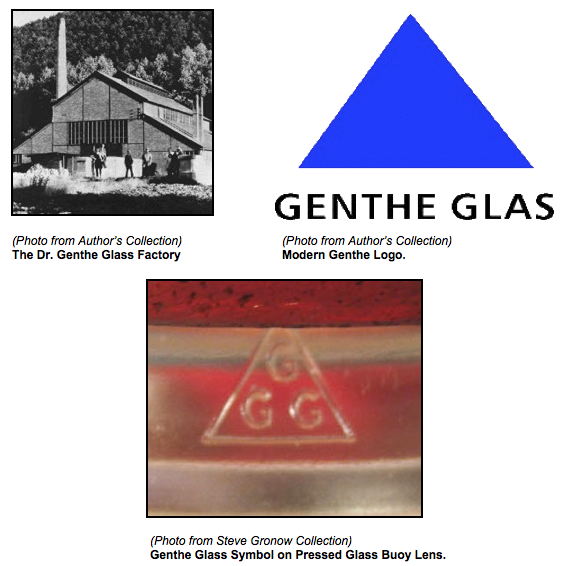Many companies were involved in the development and refinement of the Fresnel lens. Some supplied only the glass for the lenses, either in rough form, or both cast and polished. Other companies assembled the glass elements and performed finish work on the lens elements. Still other companies produced both the glass and the finished lenses. This story will be divided into several parts, each discussing one or more of these companies and their contribution to the development of the Fresnel lens.
We will describe the development of the early Fresnel lenses and define the companies and individuals who took part in this effort. Augustin Fresnel had assistance from many sources as he developed and perfected his lens. The players in this story have become blurred by time and confused due to their unusual interrelationships. Hopefully, this story will help to alleviate the confusion.
The Early Development of the Fresnel Lens
Chart of the early glassmakers and lens makers who assisted Fresnel
The Lighthouse Work of Augustin Fresnel
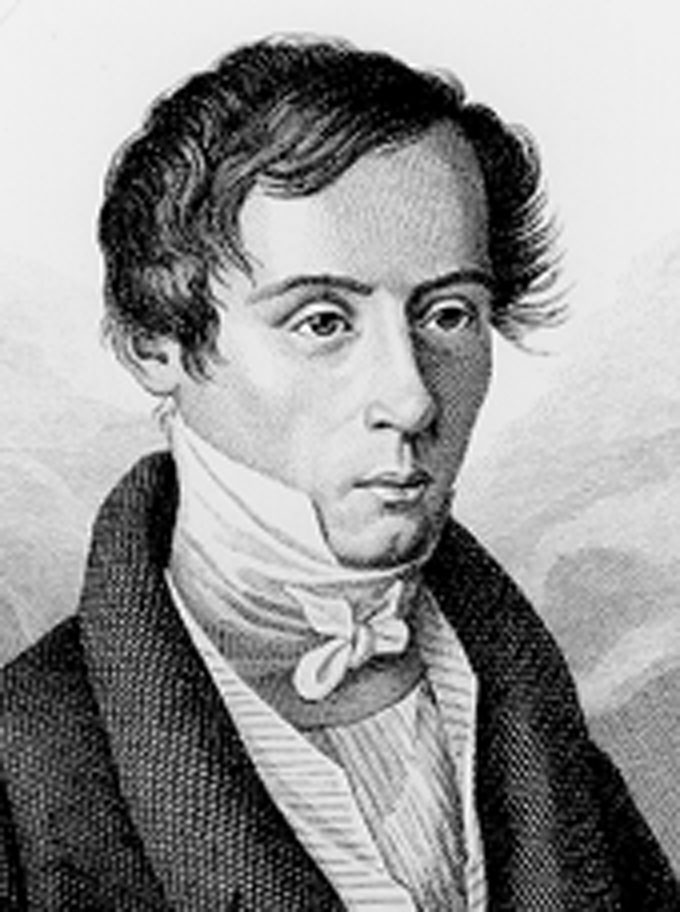
(Drawing from Oeuvres Completes d’Augustin Fresnel) Augustin Fresnel age 37.
The French Commission for Lighthouses was established on April 29, 1811. In 1819 Arago, who had become a member of the French Commission for Lighthouses in 1813, offered to make a systematic review of possible improvements in lighthouse illumination. He requested that Claude Mathieu and Augustin Fresnel be assigned as his coworkers on the project. His request was granted on June 21, 1819, and Augustin agreed to serve on the committee. Augustin produced his first report on optics and lamps for lighthouses on August 29, 1819 - just two months after starting to work on the project.
Augustin Fresnel used information from his own scientific work on optics along with ideas from Buffon and Condorcet in his lens designs. He created a bull’s-eye lens panel in early 1821 that was made with segments of rings and was specifically designed for use in lighthouse illumination. At first, his design used lens elements made from polygonal segments of glass created by the Parisian optician François Soleil Sr., and assembled with fish glue. He chose polygonal segments of glass, instead of curved segments, because he thought they would be far easier and less costly to produce. After the first bull’s-eye panel was made, Monsieur Soleil determined that he could make curved lens segments for nearly the same cost, and the design was converted to a truly circular lens panel by late 1821.
During 1822, Augustin worked on completing his design for a flashing lens using eight of his circular bull’s-eye flash panels. Each of the bull’s-eye panels refracted (deflected) the light in both the horizontal and vertical directions, forming beams of light.
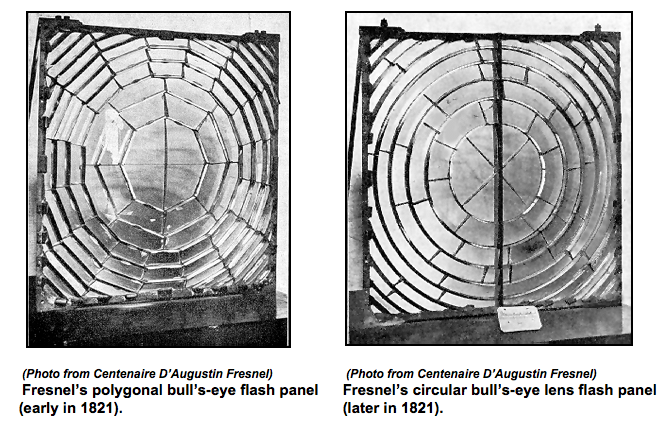
Augustin created several other forms of lighthouse lenses after his design of the first revolving, first-order lens. He took the basic design of his bull’s-eye flash panel, revolved it around its vertical axis, and created the first fixed lens in 1824. This design was made from 12 flat vertical panels formed in a circle. The main panels collected the light from the lamp and refracted (deflected) it vertically into the horizontal beam. The original design of the fixed lens directed light into 12 beams, in a nearly complete 360-degree circle. The mariner would see a constant light unless he was looking directly at the area between the beams formed by the junction of the vertical panels. The fixed lens would be perfected, eliminating the 12 beams and giving light in a complete circle, by the Cookson Glass Company in 1836 (see Cookson Glass later in this story).
The fixed lens design was further modified in 1825 when Augustin added a set of revolving flash panels to create the first fixed lens varied by flashes. The fixed lens directed light in a flat disk shape, in a nearly complete 360-degree circle. The revolving flash panels refracted the light from the fixed belt horizontally creating two or four horizontal beams of light.
Fresnel’s Assistants
Early in the development of the lighthouse lens project, Fresnel began using his younger brothers as his assistants. He had two younger brothers Léonor who had been born in 1790 and Fulgence who had been born in 1795.
Léonor Fresnel
Léonor was Augustin’s major assistant and would remain closely associated with the development of lighthouse optics over the years. Léonor replaced Augustin on his death in 1827. Léonor also worked for a few years as a consultant to the English glassmaker, Cookson, assisting in its manufacture of Fresnel lenses from 1834 through 1845. (See Cookson Glass later in this story). Little is known about Léonor Fresnel, the man, and no portraits exist of him. Léonor wrote part of the biography of Augustin’s work, Oeuvres Completes de Fresnel, published in 1866. Léonor died in 1869.
Fulgence Fresnel
Fulgence worked with Augustin as a minor assistant for only a short time during the 1820s. He was very skilled in diplomacy and was used by Augustin in that capacity to solve problems and negotiate agreements. He had studied and become expert in many foreign languages and later became a specialist in oriental and mid-eastern culture. Fulgence died in Baghdad in the year 1855.
Monsieur Jacques Tabouret (Pronounced: Tab-ur-ray)
Monsieur Jacques Tabouret was Augustin’s mechanical assistant and ran Fresnel’s development shop and laboratory. Monsieur Tabouret worked for the French Department of Bridges and Roads, as did Augustin Fresnel. He assisted Augustin in the physical production and assembly of the metal and glasswork used in the lenses, clockworks and other lighthouse machinery. Monsieur Tabouret went on to work at Chance Brothers, in England, during its early development of lighthouse lenses. (See Chance Brothers Glass and Lens Works later in this story).
The Soleil Family Dynasty of Lens Makers
François Soleil Sr. Lens Works (Pronounced: Frans-wah So-lay-ea)
Little is known about the Parisian optician, François Soleil Sr. There is also great confusion related to the name Soleil, and particularly the name François, due to the use of this name as a given name and a family name by several interrelated family members.
The patriarch of the family was François Soleil Sr. who worked directly with Augustin Fresnel in the creation of the first Fresnel lens. The date of François Soleil’s birth is uncertain; he died in 1846. He had a son Jean-Baptiste Soleil (usually referred to as François Soleil Jr.) and two daughters. His daughter Adelaide married Jean Jacques François.
Starting in 1816, François Soleil Sr. operated a small precision handcrafted scientific optical instrument company. In late 1819, Augustin Fresnel contracted with Monsieur Soleil Sr. for the creation of the optics of his first lens. After the first lens was completed for Cordouan lighthouse, Monsieur Soleil Sr. saw the potential future demand for Fresnel lenses in France and elsewhere. He decided to expand his business and created an additional factory exclusively for Fresnel lens production. He founded and equipped his factory in 1825, at Chapelle, Saint Denis in Paris. Production remained limited because it was difficult to find good workmen and to find a supply of nearly optical quality glass. At that time, the products of the glass manufacturers at Choisy-le-Roi and Saint Gobain had great difficulty in meeting the requirements of this new industrial activity.
When François Soleil Sr. retired in 1838 he divided his business into two parts. The Fresnel lens business remained at Chapelle, St. Denis in Paris, and was rented to his son-in-law Jean Jacques François. The optical instrument business was given to his son Jean-Baptiste François Soleil (Jr.) and was located at 35 (later 21) Rue de l’Odeon in Paris.
Some of the early work of François Soleil Sr. on Fresnel lenses can be seen from the following letters written by Augustin Fresnel to Monsieur Tassaert, Director of the Saint Gobain Glass Factory.
“Paris, 21 April 1822”
“Sir,”
“The new glass arrived at just the right time; Monsieur Soleil had just made up a lens in reheated and remolded glass,* and was going to have to produce a second, in order not to leave his workmen without work.”
“It will not be bad if you send us another tray, because one of the first pieces was found to have a defect; and, in general, there is not any inconvenience at all to cast one or two additional pieces of every type, in case of accidents. Moreover I hope that Monsieur Soleil will have several other lighthouse lenses to execute, and that the remaining pieces will thus be used.”
“The request that he made of you is calculated for ten lenses: it is consequently necessary to have ten rings of every type. He will write you about how many pieces he selected for each of the new rings, which he sent to you for the grinders last Monday. It is moreover a thing that you could verify with the grinders and with the cutting pattern for composing the complete rings. As for the ring numbers 2, 3 and 4, I remember that it is necessary to have for each ring, two pieces of number 2, three of number 3, and four of number 4. Therefore in deducting those that you sent from the total numbers required of 20, 30 and 40, you will know how much there remains for you to run.”
“The glasses for which M. Soleil now has the most pressing need are those of the ring numbers 5 and 6, and he asks you to send him some as soon as possible.”
“Accept, [etc].”
“A. FRESNEL”
* Note: The French words used “en verre refoulé” are not completely clear in current French. The word refoulé today means repressed, not remolded. Indications are that Soleil received the first glass from Choisy-le-Roi, which was of poor quality with many bubbles. Soleil reheated the glass and remolded it to remove the bubbles and to partially form it into the required shape. When the first glass was received from Saint Gobain it also had to have this hand processing step performed. After the first few pieces of glass, Saint Gobain was able to correct the problem.
“Paris, 26 June 1825”
“Sir,”
“Monsieur Soleil complains, with reason, that your workers are not careful enough in the casting of his rings. I noticed at his place a large number of glass pieces that cannot serve, although they contain good enough material, because they were poorly cast. In one, the side plan presents a strong angle that renders its extremities too thin, while the other is too thick; in the others, the angles are so defective that, in removing even a considerable glass thickness, one could not obtain a sharp edge.”
“Thanks to the exaggerated dimensions of the molds, most of the pieces that you sent present enough width and thickness to be machined, although all the ridges are extremely rounded. Would it not be possible to obtain sharper edges and a more correct casting, by heating the molds, if it was necessary, to expel all the material inside. If one was sure that with a little care one could exactly make the glass forms in the molds, one could employ a narrower mold that would thus diminish the work of the machining.”
“I have the honor to be with your consideration the more distinguished, Sir, Yours, etc.”
”A. FRESNEL”
At the end of the year 1821, Colonel Colby, of the British Royal Engineers, reported on the early design and testing of the Fresnel system to Trinity House, the British Lighthouse Authority, and to Robert Stevenson, Engineer of the Northern Lighthouse Board in Scotland. Colonel Colby also tried to order a Fresnel lighthouse lens from François Soleil Sr., but Monsieur Soleil Sr. explained that it could not be completed until the lens for Cordouan was finished and installed; and Colonel Colby’s order was cancelled.
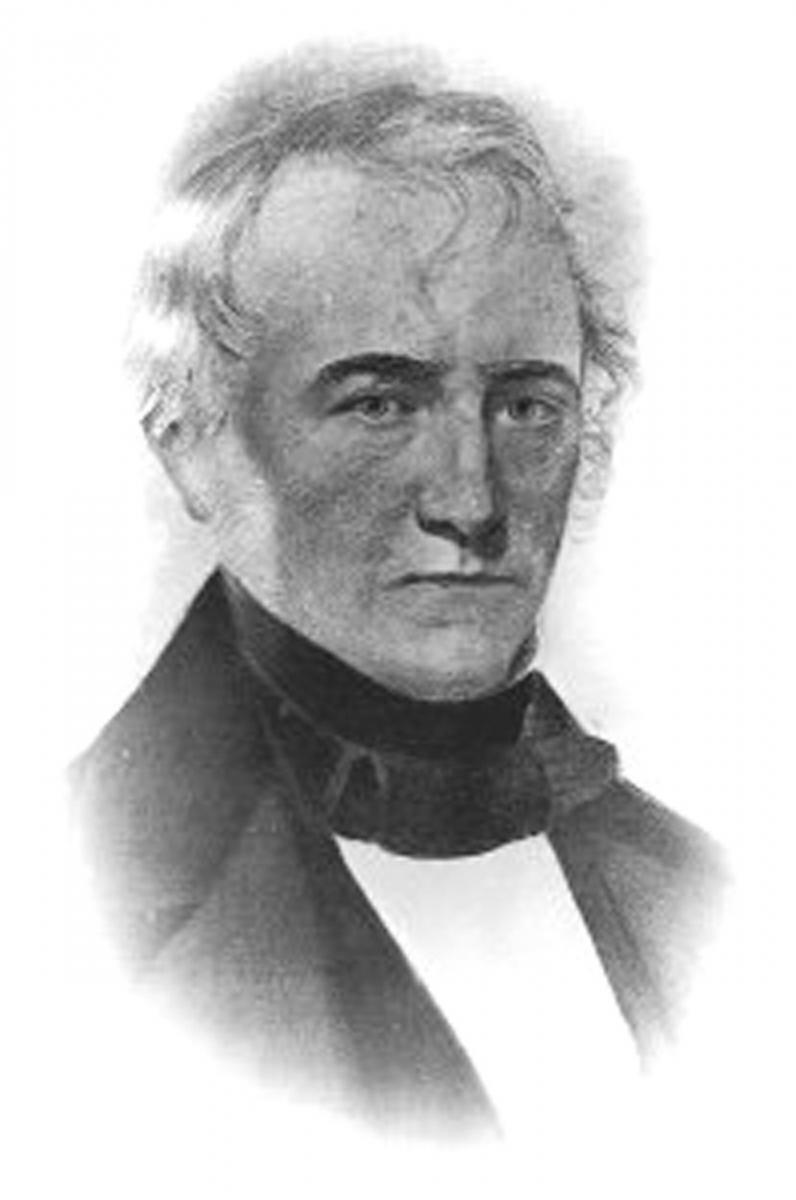
Colonel Thomas Colby
On July 20, 1823, the first dioptric device was installed on the tower of Cordouan where it replaced twelve large parabolic reflectors, which had illuminated Cordouan since 1791. During the 1820s, Trinity House, in England, attempted to have a Fresnel lens produced by Cookson Glass. There were great difficulties at Cookson and no lens was made. The British had no lens for testing until Robert Stevenson was able to purchase two bull’s-eye panels from François Soleil Sr. in 1824, which did not arrive until 1825. The British were not able to obtain a lens from Cookson Glass until one was made for the Northern Lighthouse Board in Scotland in 1831. In the meantime, the English and Scottish boards continued to report on the perfection of their catoptric (reflective) systems, which had been improved extensively with the passing of the years.
In France, more than twenty lighthouses were built and equipped with Fresnel optics during the following fifteen years. This number appears small, but it is necessary to understand that the builders needed to correct many technical difficulties to provide the wide range of lenses needed by the Lighthouse Service in France, and they were permitted to construct only one first-order lighthouse a year.
Jean Jacques François Lens Works (Pronounced: Jean Zh-ak Frans-wah)
Jean Jacques François was the son-in-law of François Soleil Sr. In 1838, when François Soleil Sr. retired; Jean Jacques François took over Soliel’s factory that produced Fresnel lenses. Jean Jacques François also called himself François Jeune, which literally means François the younger. At this time, Jean Jacques François’ lens factory and Augustin Henry’s (later known as Henry-Lepaute) lens factory were the only factories producing Fresnel lenses in France. Jean Jacques François had a relationship with Augustin Henry whose factory supplied all of the clockworks needed to rotate the flashing lenses. Jean Jacques François built several important early lenses. He allied himself with Léonor Fresnel who wrote in a report to the French Lighthouse Commission as follows: “Soon after these first tests, young Monsieur François undertook, for Scotland, the execution of a lens device of the first order destined for the lighthouse of Skerryvore.”
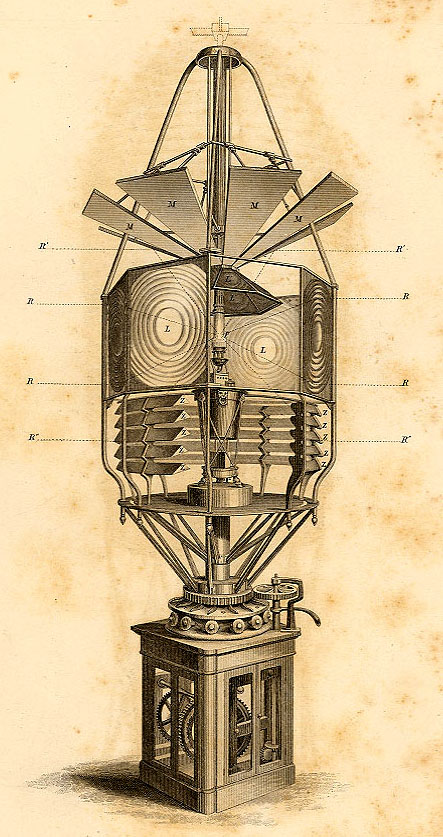
(Drawing from Account of the Skerryvore Lighthouse) Jean Jacques François’ Skerryvore Lens built in 1842-43.
Jean-Baptiste François Soleil Jr.’s Instrument Business
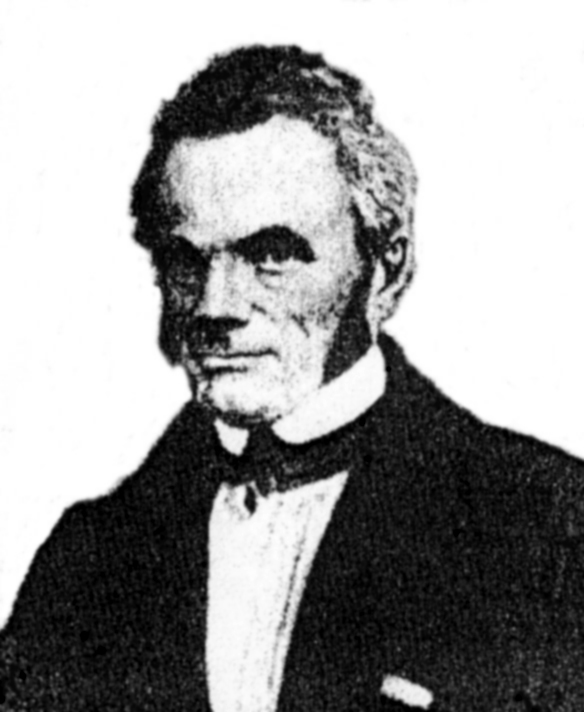
Jean-Baptiste François Soleil, usually called François Soleil Jr.
In 1838, when François Soleil Sr. retired, Jean-Baptiste François Soleil Jr., Soleil’s son, took over Soleil’s optical instrument business. Jean-Baptiste had worked in his father’s Fresnel lens business since he had completed school. After his father’s retirement Jean-Baptiste continued to assist his brother-in-law, Jean Jacques François, in the lens business while continuing and growing the optical instrument business. In 1839, Louis Jules Duboscq (Pronounced: Due-bo-sk) married Jean-Baptiste François Soleil Jr.’s daughter and in 1849, on Jean-Baptiste François Soleil Jr.’s retirement, took over the optical instrument business. Duboscq later went on to develop one style of the electric-arc lamps that were used in lighthouses in the 1850s and later.
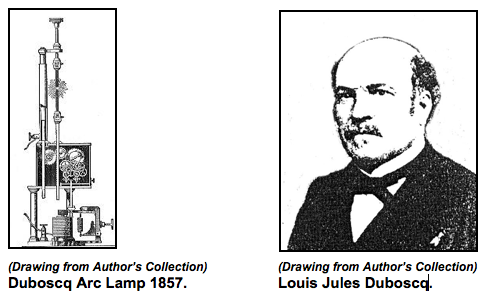
Theodore Létourneau Lens Works (Pronounced: Lay-turn-oh)
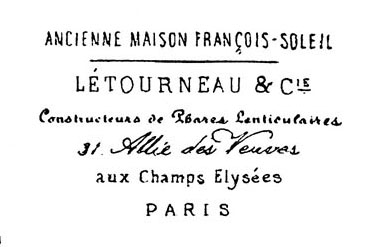
(Writing from a Létourneau lens drawing) Létourneau Name and Address.
Theodore Létourneau was the son-in-law of Jean Jacques François. Létourneau took over the former Soleil factory in 1844, which was then operated by Jean Jacques François and located at 37 Avenue Montaigne. He continued to manufacture Fresnel lenses and other lighthouse equipment until 1852 when his company was purchased by Louis Sautter. (See the Louis Sautter Lens Works in Part 2 of this story). Létourneau also had a working relationship with Augustin Henry (later known as Henry-Lepaute) during the years 1844 to 1852 and they jointly produced some lighthouse equipment. In the late 1840s the Létourneau offices were moved next door to 31 Allie Veuses, in Paris.
Theodore Létourneau was responsible for two major Fresnel lens design improvements. In 1848, Létourneau proposed lengthening the duration of the flash in rotating lenses by dividing each flash panel into two vertical portions. He then set the two halves of each panel at a slight outward angle (about 5 degrees) to each other. This change increased the divergence of the light from each flash panel, thus increasing its duration of observability to the mariner while only slightly decreasing its power output. Létourneau also proposed a way to improve fixed lenses varied by flashes. The problem with this style of lens was that the flash was produced by a rotating flash panel, formed of only vertical lens elements, revolving outside the standard fixed lens. The light was forced to travel through both the inner fixed lens and the outer flash panel in order to produce a flash. The light traveling through two glass lenses reduced its output by up to 20 percent. Létourneau’s improvement was to build a combination lens with alternating fixed and ‘bull’s-eye’ flash panels that rotated. The new lens still had the fixed varied by flash characteristic, but required only a single thickness of glass, thus increasing the power of the flash by up to 20 percent.
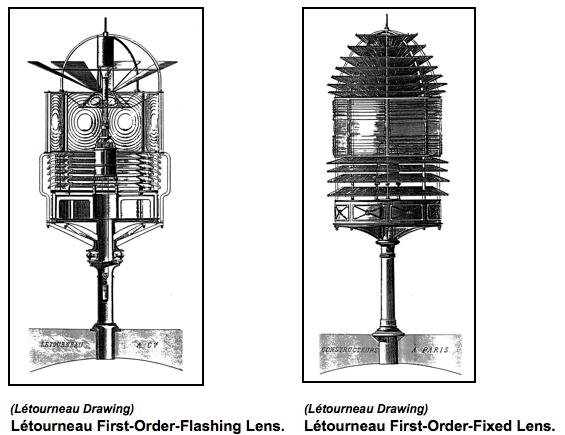
Choisy-le-Roi Glass Works
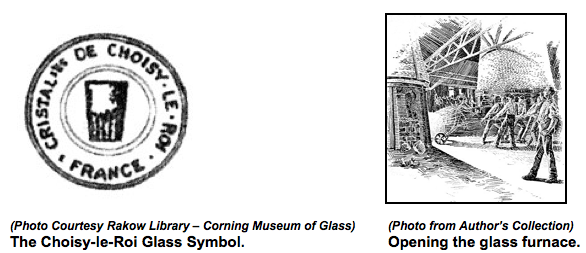
The Choisy-le-Roi factory was founded near Choisy-le-Roi located just south of Paris, France in 1820, by Monsieur Grimbolt and remained in operation until 1851. Between 1823 and 1848 the factory was directed by Georges Bontemps (Pronounced: Bon-tohm) a master in making crown and optical glass. The Choisy-le-Roi factory also became the pioneering establishment, in France, involved in the making of various types of colored glass.
In January 1822, during the construction of the very first Fresnel lens, we find the following report:
“The Director General of the Department of Bridges and Roads, after various experiments done at the observatory and at the Arch de Triumph de l’Etoile, decided that a lens lighthouse would be established on the tower of Cordouan; this was based on the drawings of Monsieur Augustin Fresnel, engineer of the Department of Bridges and Roads. Monsieur Soleil, engineer optician, was charged with the construction of the echelon lenses intended for the new lighthouse, the composition was of various related small pieces of glass of the thickness of 18 to 20 lines (Ed: a line is a measurement of a little less than 3/32 of an inch), these pieces, held together by means of fish glue, formed concentric rings that were difficult and expensive to construct.”
“Monsieur Soleil requested the glassworks of Choisy-le-Roi to cast the rings, in one piece, or in four or six pieces; but the pieces thus prepared exploded while being worked.” “Monsieur Darcet, who with Monsieur Soleil was part of this fruitless attempt, counseled him to inquire about it to the factory at Saint Gobain.”
As can be seen, it was due to this first failure at Choisy-le-Roi that the Royal Glass Works at Saint Gobain became involved in the development of Fresnel lenses. Monsieur Soleil tried to have both Choisy-le-Roi and Saint-Gobain perform the work. However, problems continued with the glass from Choisy-le-Roi, as can be seen from the following extract from a letter dated August 4, 1826 from Fresnel to Monsieur Bontemps at the Choisy-le-Roi factory.
“I waited some days to answer you, wanting to first assure myself that the material of your last casting was as full of bubbles and striae that it appeared to me initially. For that, I cut and polished two facets on three pieces selected among those where the glass appeared the least bad, and I recognized that this matter was not resolved. I would expose myself to the just reproaches of my Administration in accepting glass so full of defects………”
Problems remained with the early glass procured from both sources and especially from Choisy-le-Roi during the 1820s, and therefore, virtually all production glass came from Saint Gobain by 1830.
Bontemps continued to direct the company and encouraged it to manufacture items with greater quality and of a more serious character. Of the four prizes awarded by the Encouragement Society at the competition in 1835, he won one for flint glass and another for crown glass, both used in optics. In 1848, Monsieur Georges Bontemps left Choisy-le-Roi and went to work for Chance Brothers, in England, where he headed production of optical and specialty glass manufacture. (See Chance Brothers Glass and Lens Works in Part 4 of this story). Bontemps leaving resulted in the end of Choisy-le-Roi’s involvement with the making of glass for Fresnel lenses.
Saint Gobain Glass Works
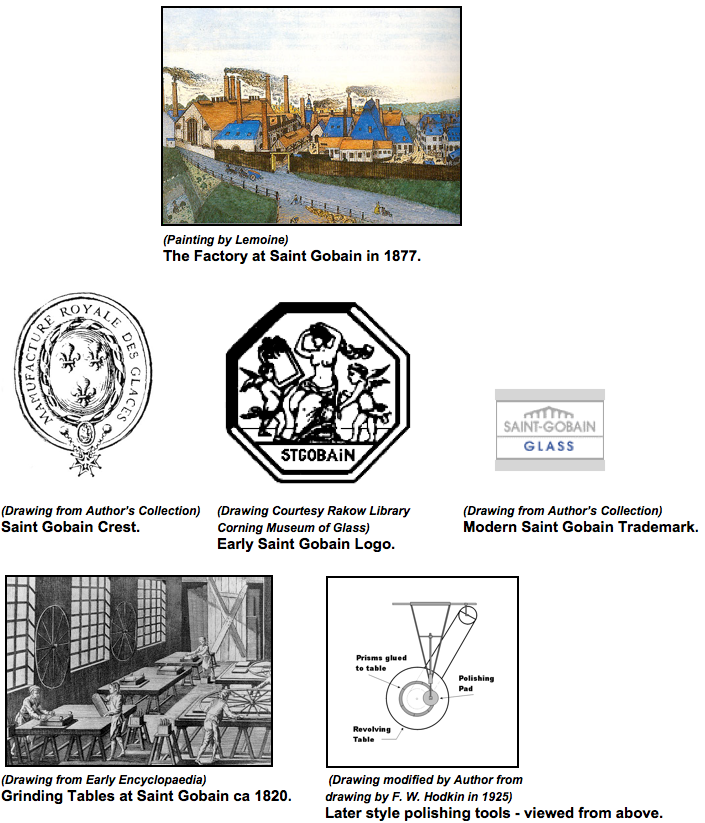
Saint Gobain was originally formed in October 1665 as the Royal Glass Works by Monsieur Colbert for French King Louis XIV. It received a royal privilege that allowed it to have a monopoly on the production of mirrors within France and had its factory in Paris. In early 1667, the Tourville Glass Company was merged into the business.
Glass companies at that time used wood to fire their furnaces and were located close to forests to allow the purchase of fuel at the lowest prices. The Royal Glass Works used the Tourville factory, located in Normandy, to produce most of its glass and to supply wood to the small glass making operation in Paris. Most of the Paris factory was devoted exclusively to the grinding and polishing of glass for use in large mirrors.
Still another glass company began operations in 1692 on the site of the Château of Saint Gobain some 130 miles northeast of Paris; in 1695 the Royal Glass Works bought out this company. Saint Gobain became its main factory due to the fact that it was located within the immense Saint Gobain forest and had a large plot of ground on which it could expand. In 1789, the royal privilege was revoked and the company became known as Saint Gobain Glass.
Saint Gobain was the first glassmaker to successfully develop the process of casting large sheets of glass on iron tables, a process that would assist in the casting of prisms and dioptric lens elements some one hundred and twenty years later for Augustin Fresnel.
Monsieur Soleil asked Saint Gobain to make prisms and lens elements for some of the first Fresnel lenses after his earlier problems in obtaining quality glass from the Choisy-le-Roi factory. The glass used was the highest grade of what was known as ‘Crown Glass,’ but was not true optical quality glass. Saint Gobain produced the glass and the prisms and lens elements were formed in iron molds and were then sent to Paris for polishing. The early polishing process could not complete the very precise final polish. This was done by hand, using extremely fine English red rouge. The Saint Gobain factory, in Paris, actually contracted out the final polishing step to women in the local area. It is said that they were so proficient in polishing the prisms that the edges became razor sharp and the very last step in the hand process was to slightly blunt the edge of the prism so that it could be handled without cutting the hands of the final assemblers. Later, metal tables were used and the grinding machines were improved becoming faster and more accurate, allowing the hand-processing step to be eliminated.
One of the earliest connections between Augustin Fresnel and Saint Gobain occurred when Augustin asked Fulgence Fresnel, his youngest brother, to meet with Monsieur Tassaert, the scientist director of the Royal Glass Factory at Saint Gobain, in January 1822. After that meeting Augustin sent the following letter:
"Sir,”
"The obliging welcome that you had the goodness to give to my brother, and of which it pleases me to testify to you his recognition, makes me hope that you will want to interest yourself in the success of the casting of the curved prisms of Mr. Soleil. If it succeeds, as all believe it will, you will have performed a great service in the lighting of the lighthouses. While waiting, Mr. Soleil continues to construct lenses with small glass pieces; but you will accelerate his work greatly, if you have the goodness to send him, quickly, the first molded prisms.”
" Accept, etc.”
"A. FRESNEL"
Soon, thanks to the competition between the Choisy-le-Roi Glass factory and the Saint Gobain Glass factory to build larger curved pieces of glass, Fresnel and Soleil were able to greatly reduce the number of the subdivisions within the concentric rings of the large dioptric panels. This was an improvement that increased their useful light throughput by half. However, problems with their manufacture plagued Saint Gobain, just as they had Choisy-le-Roi, and the lens rings were being constantly sent back and forth between Monsieur Soleil and Saint Gobain until they could be produced correctly, as can be seen in this letter from Fresnel to Monsieur Tassaert:
“Paris, March 12, 1822”
“Sir,”
“Monsieur Soleil received the glass prisms that you had the goodness to send him, and found the material beautiful. He asks you to continue the molding and grinding, until the completion of ring numbers 10, 20, 30 and 40, and of ring numbers 1, 2, 3 and 4, while deducting the first ones received.”
“He will send you, toward the end of this week, four ground rings for ring numbers 5, 6, 7 and 8, and you should indicate, at the same time, the number of remaining pieces that are necessary from him.”
“He not having preserved the grinding patterns for 1, 2, 3 and 4, is going to try to send you a new ground one of every type, from the molded pieces of glass that he received.”
“I ask you, Sir, to have the goodness to send him the pieces that you will mold of the numbers 5, 6, 7 and 8, as soon as possible, in order to complete the lens of which you sent him the first numbers.”
“M. Soleil wants to know how much these glasses will cost him delivered. I ask you to treat this favorably, so that it can support the competition from the English, when they begin to copy our lighthouse lenses.”
“Accept, [etc].”
“Augustin Fresnel”
There is often discussion in lighthouse literature of the purchase of glass for Fresnel lenses from Prémontré. The glass factory at Prémontré was founded in 1827 as a rival to Saint Gobain. In 1843, Saint Gobain and another company, Saint Quirin, jointly purchased the Prémontré factory and split its assets. Through this purchase the distinction between Saint Gobain and Prémontré became blurred. Some glass for Fresnel lens production was purchased from Prémontré while it was a separate company, but most glass was purchased from it when it became just another factory location of the Saint Gobain Company after 1843.
Saint Gobain further expanded when it built another factory located in Chauny a few miles to the east of Saint Gobain. The Chauny factory began the development of mechanized grinding and polishing of glass in the early 1800s. However, only about 30% of the grinding was successfully mechanized by the 1830s.
Saint Gobain became the major producer of all glass used by the French manufacturers of Fresnel lenses. Jean Jacques François, Létourneau, and later, Henry-Lepaute, Sautter Lemonnier & Cie, and Barbier, Bénard and Turenne purchased all of their glass from the Saint Gobain glass factories. In 1880, Louis Sautter wrote an interesting description of the work at Saint Gobain as follows:
“It was only with a lot of pain and after several fruitless attempts that we managed to cast the large glass pieces, which compose the optic part of the first-order devices.”
“We first had recourse to the process in use in the manufacture of the optical glass used for astronomical objectives, that is to say to the re-softening, and we could not obtain a complete ring in this way as well as we could with pieces of small dimension that we put together tip to tip to make rings. Today the glass is taken from the crucible by means of iron ladles and is cast directly in ingots or in a mold made of cast iron. We leave it there to cool slowly, which leaves it with a shape that compares itself well with the one that it must have after the cutting.”
“The glass of Saint Gobain that is exclusively employed for the construction of the lighthouses in France has the following composition:
Silica 72.1 percent
Soda 12.2
Lime 15.7
Alumina and iron oxide traces”
“The large proportion of silica contained in this glass, renders it very hard and unaffected by the air. Its hue is lightly greenish; it is also lacking in lines and streaks, being a glass that did not undergo the operations of mixing, slow cooling in the crucible, sorting and re-softening reserved for the glasses used as objectives. The known defects under the name of bubbles or boullions, sand, stones, etc., that originate from imperfect refining, are very rare. It is good to notice that these defects that are harmful to the appearance of the lens have only a very slight influence on its optical properties.”
“It would be easy to return to completely white glass by adding a certain lead proportion; but it would then become softer and more subject to deterioration.”
“The index of refraction of the glass for lighthouses from Saint Gobain is about 1.54.”
“The losses that the light undergoes while crossing a glass piece originate from two different causes:
1- on one hand reflection of the rays of light at the entry and exit surfaces
2- absorption during the passage from one surface to the other”
“The loss by reflection varies following the degree of polish of the surfaces and the angle of incidence of the light. With the well-polished glass of Saint Gobain, it can be valued at ten percent of the incident light, for the understood incidences between the normal and 45 degrees. Beyond 45 degrees, the loss increases progressively.”
“The loss by absorption depends on the nature of the glass and its measured thickness. With the glass of Saint Gobain one can value it at ½ percent per centimeter of thickness.”
“The glass pieces of circular form that make up the greatest number of the pieces of lighthouse lenses are worked on turntables in both the vertical and horizontal planes. The ring, cast as a single piece or in several parts and previously heated in an oven, is stuck by means of melted pitch in a circle and is raised some centimeters above the turntable. During this operation the workman turns the turntable, and centers the ring by hand. Then the workman leaves it to cool and later begins the work on the rough-hewn piece. It consists of applying, against the surface of the mounted ring in rotation on the turntable, a rubbing arm with a coating of wet sandstone that slowly wears the surface of the glass and makes its inequalities disappear. When it is sufficiently smooth, the workman imparts to the rubbing arm a dual movement designed to remove the grooves dug by the grains of sand and to give to the surface the calculated curvature that was assigned for it based on the place that the ring must occupy in the lens. To affect this, an arm is put on the tip of the rubbing arm, which is forced to oscillate between two points. The length of the arm determines the radius of curvature of the surface; the position of the center determines its angle in comparison with the horizontal surface. Some gauges made with great care, are applied frequently on the surface during the course of the work and allow exact size verification. When the rough-hewn glass is completed and it cannot be seen to have a remaining rough surface, the workman stops the work with the sandstone and passes to the work with the emery. The ring, the turntable and the rubbing arms are washed with the greatest care, until all trace of sandstone disappears. Then the workman resets the tools and applies on the glass not more sandstone, but emery diluted in water. It is only gradually and while employing four more emery types and finally another with the name Douci that the workman brings the glass surface to the designated state that allows it to be polished. Between every change in emery the turntable must be washed and if the workman does not do this washing with enough care he exposes himself to produce scratched surfaces.”
“After a last washing, the lens piece passes to the final polisher, who works it by means of English Rouge (iron peroxide) diluted in water and applied with a brush on the surface of the ring. During this phase of the operation the cast iron surface of the rubbing arm is covered with felts.”
“Some details of the manufacture vary following the nature of the glass pieces, but all pass through the same series of operations to arrive from the crude state to the polished state. Their optical qualities depend principally on the exactness of their geometric forms and consequently on the quality of construction of the tools with which one works them. Slight curvature differences, which are impossible to notice, can increase the divergence and consequently diminish the intensity of the luminous beam by a large proportion. All shape inaccuracies translate into a loss of light.”
“The distortions that cannot be avoided in the neighborhood of the edges of the prisms are a cause for loss that it is important to diminish while making the edges as fine as possible and while not multiplying the prisms beyond measure with a view to reduce their thickness. There would not be any advantage to drop below a width of about ten centimeters that is adopted today for the reflecting surfaces of the catadioptric prisms of the first three orders.”
Saint Gobain continued to supply all of the French lens makers with glass throughout their years of production. It remains in business today, making glass, chemicals and ceramics of all types and is one of the largest firms in France.
Cookson Glass Works
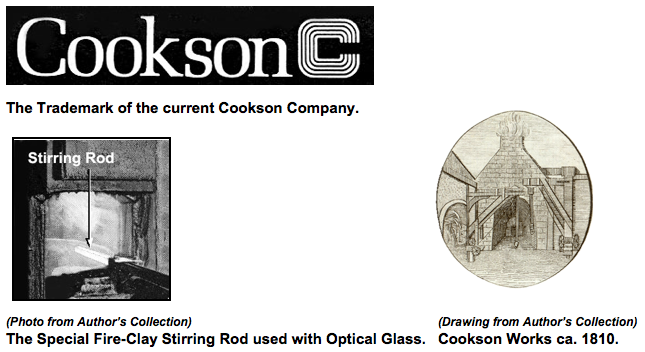
Isaac Cookson bought shares in a bottle glass company in New Castle, England in 1720. Isaac’s son John became a partner in the Cookson Glass Company in 1737 and began producing crown and plate glass for windows at South Shields near New Castle. On John Cookson’s death in 1783, his son Isaac took over control of the glass company with his two brothers. Later, he was assisted in the business by three of his sons one of whom was William Isaac Cookson who was directly involved during the time that Fresnel lenses were in production. The Cookson Glass Company also owned foundries and chemical plants. Cookson Glass was heavily involved in the early production of experimental Fresnel lenses in Britain and produced the first complete Fresnel lenses used in England, Ireland and Scotland.
In 1845, the Cookson Glass Company went out of business and was sold to a consortium headed by Robert W. Swinburne. The consortium included Robert Stevenson, the famous Scottish lighthouse engineer and builder of the Bell Rock lighthouse, who was a close friend of Isaac Cookson. Robert W. Swinburne was in business for about one year and made only one Fresnel lens installed at the Hartlepool Heugh Lighthouse. The remainder of the company became the South Shields Plate Glass Works and remained in business until 1891. The Cookson Company returned to the glass business in the 1900s and remains in business today. Note: You may be aware of another connection to the Cookson family through reading of the many novels written by Isaac’s great-great granddaughter in-law, Catherine Cookson.
Cookson Lens Works
Fresnel lenses were only produced for a short time by Cookson Glass. Trinity House had requested the construction of a lens in the mid 1820s, but it could not be produced. The first Fresnel lens panel produced was ordered from Cookson glass by the Northern Lighthouse Board, in Scotland, in the year 1831 for testing purposes.
William Cookson’s first Fresnel test lens was very unusual in its construction. In 1748, the Count de Buffon proposed a new style of lens made by cutting a piece of glass into steps. As an example, if Buffon wished to diminish the thickness of a glass lens, he divided the exterior curved surface of the lens into parts and moved each of these parts toward the center of curvature until there remained only a thickness of one inch in the center of the lens, a step being formed on each side by moving the corresponding parts an equal amount. Buffon produced a lens in steps, which had about the same focal distance and was only about one‑third as thick as it was at first, which was a great advantage.

(Drawing by Author from drawing by Buffon) A lens ground back in the style Buffon proposed.
The lens requested by the Northern Lighthouse Board in 1831, was made from a single slab of glass as Buffon had proposed. The only known lenses to have been produced based on the Buffon design were a lens made in 1780, by the Abbé Rochon in France, which was only twelve to fifteen inches in diameter, and the aforementioned lens by William Cookson, which was nearly 30 inches in diameter.
In February 1833, the Northern Lighthouse Board held a trial, which Sir David Brewster and other important persons attended. They tested the one-piece lens from Cookson, a flint-glass lens proposed by Brewster, a true Fresnel lens bought from France, and their current reflectors. It was found that the French lens was comparable with the lens made by Cookson and was superior to Brewster’s flint-glass lens. The French lens produced light equivalent to seven of the best Scottish reflectors.
The English and Scottish lighthouse authorities wanted to produce all Fresnel lenses and other lighthouse equipment in their own country and persuaded the Cookson Glass Company to begin production of Fresnel lenses in 1834. This time Cookson brought in Léonor Fresnel, Augustin’s brother, as a consultant and produced Fresnel lenses from individual pieces and prisms as done by the French lens companies. The first of these better designed Fresnel lenses, built by the Cookson Co., was installed in Scotland in 1835, in the Inchkeith lighthouse. This was quickly followed in 1836 when the first Fresnel lens, also built by the Cookson Co., was installed in England at the Start Point lighthouse. In all about 15 very early Fresnel lenses were made by the Isaac Cookson Glass Company for use in England, Ireland and Scotland.
A major improvement in Fresnel lens design was made by Cookson Glass Company in 1836. At that time it was thought impossible to construct the central drum of a fixed lens based on a truly circular form. The fixed lenses made up to that time were actually made in the form of polygons with 12 to 32 sides. In 1836, Cookson was able to construct the first circular drum segments for a fixed lens, dramatically improving their optical characteristics. The French lens manufacturers quickly followed Cookson’s lead and from that time forward fixed lenses were formed into circles of glass that were separated into panels.
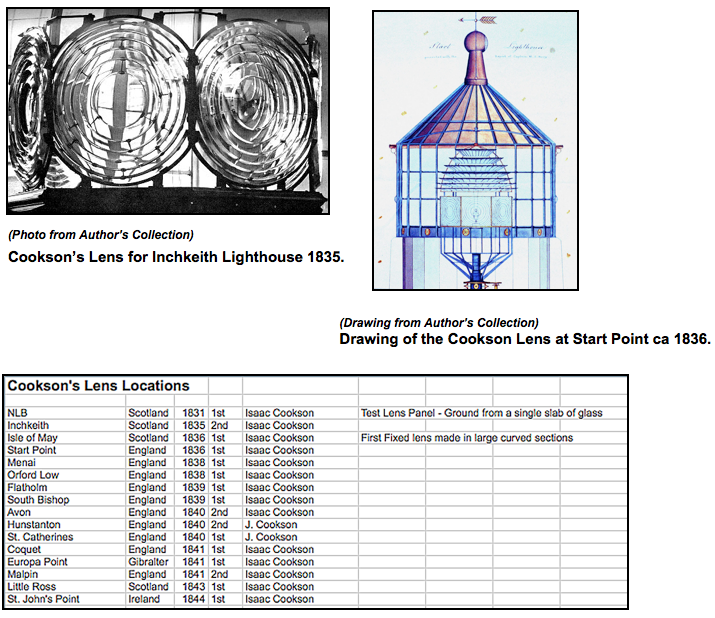
Louis Sautter Co.
In this article the Louis Sautter Company, in France, is described from its beginning as the Fresnel lens maker originally owned by François Soleil Sr. We will discuss Sautter’s involvement in the production of Fresnel lenses and other lighthouse equipment for the world market from 1852 to the company’s final demise when it was bought in 1970.
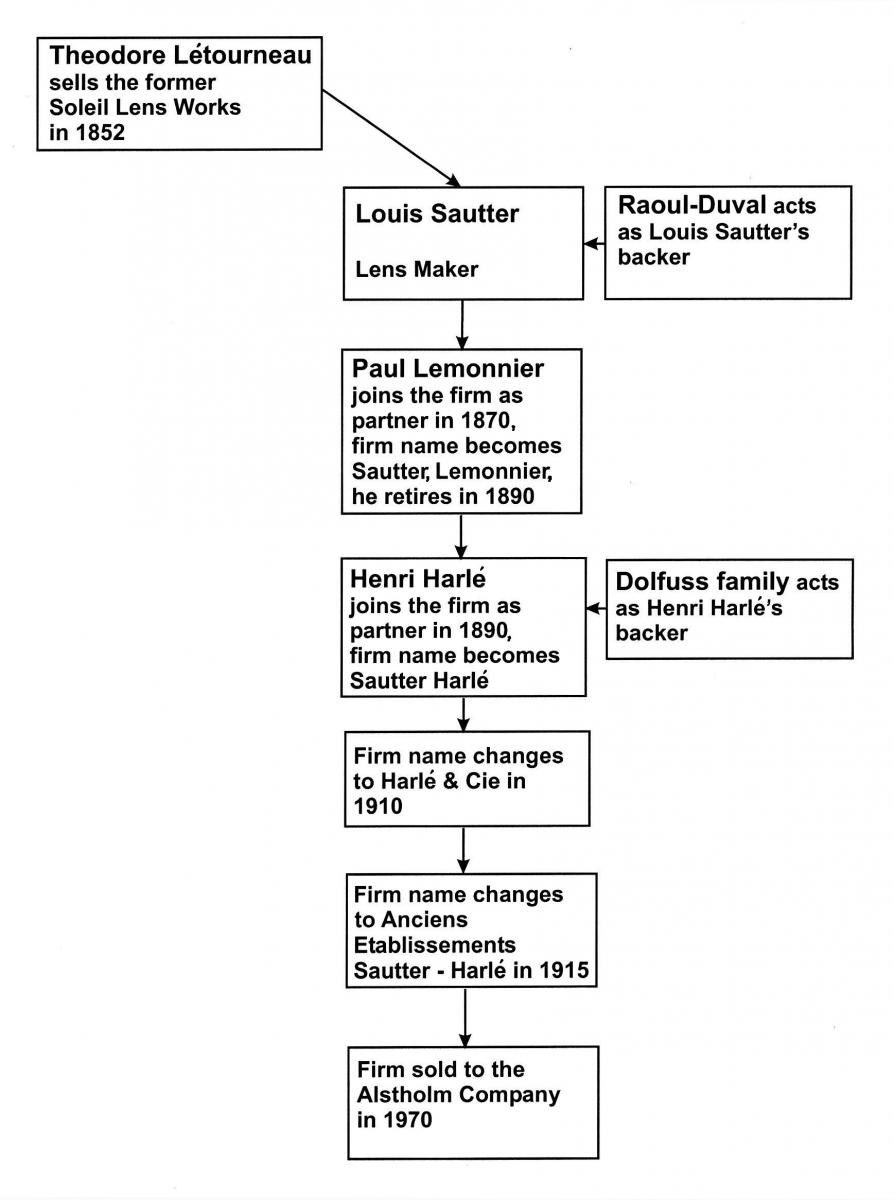
(Chart by Author) Louis Sautter Lens Works through Time.
Louis Sautter Lens Works
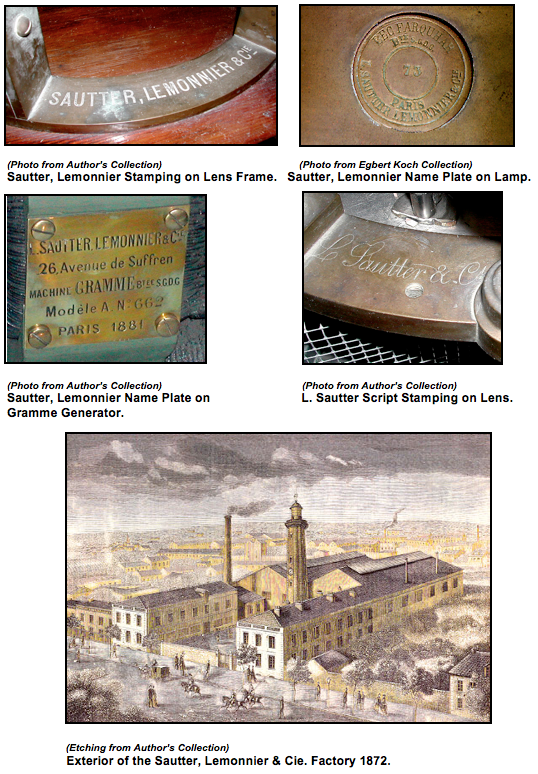
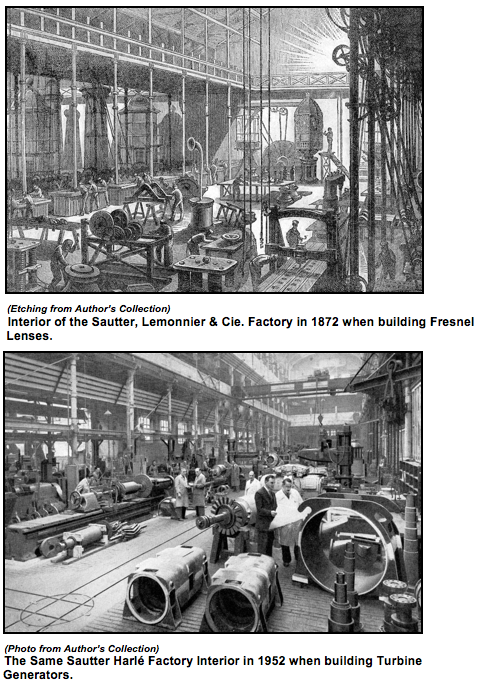
Louis Sautter (Pronounced: So-tay)
Louis Sautter completed engineering school at the Central School of Arts and Manufactures in 1846. Helped by one backer, Fernand Raoul-Duval, Sautter entered the navigation aids business in 1852, when he assumed ownership and management of the company that would carry his name. The business was previously owned by François Soleil Sr., which by this time had passed from him to his son-in-law Jean Jacques François and ultimately to François’ son-in-law Theodore Létourneau. The factory was then located at 37 Avenue Montaigne on the Champs-Elysées in Paris.
Sautter immediately began to improve on the lens designs that had been made by Létourneau. He introduced new construction methods and increased the quantity and quality of lenses produced.
Sautter’s first lens sent to America was the third-order lens made for Alcatraz Island, California in 1853. The American Lighthouse Board split its lens purchases roughly fifty-fifty between Henry-Lepaute and Louis Sautter during the main conversion to Fresnel lenses in the years 1853 through 1860.
In 1854, two years after his arrival as the head of the company, Louis Sautter submitted his first patent relative to the construction of lighting for lighthouses: "a modification in the construction of the mechanical part of the rotating devices, for lighthouses using flashing lenses, and a new system of lamps for the lighting of these lighthouses.” Many other industrial patents followed this first submission. According to one of his engineers, Sautter also developed designs that allowed improvements in the size of the glass that could be delivered by Saint Gobain.
Sautter worked with Leon Foucault in 1860 to develop an improved rotation clockwork regulator. Sautter became a major supplier of lighthouse equipment by 1861. Monsieur Reynaud, Director of the French Lighthouse Service, stated that: “The administration always desires to maintain two construction establishments for lighthouses in Paris (on a plan of equality) and therefore distributes the work as equally as possible.” The two firms were Henry-Lepaute and Sautter.
In 1867, the company moved to 26 Avenue Suffren in Paris, not far from the Eiffel Tower. Today its former factory workshops are mostly demolished and what remains is completely surrounded by apartments and other business buildings.
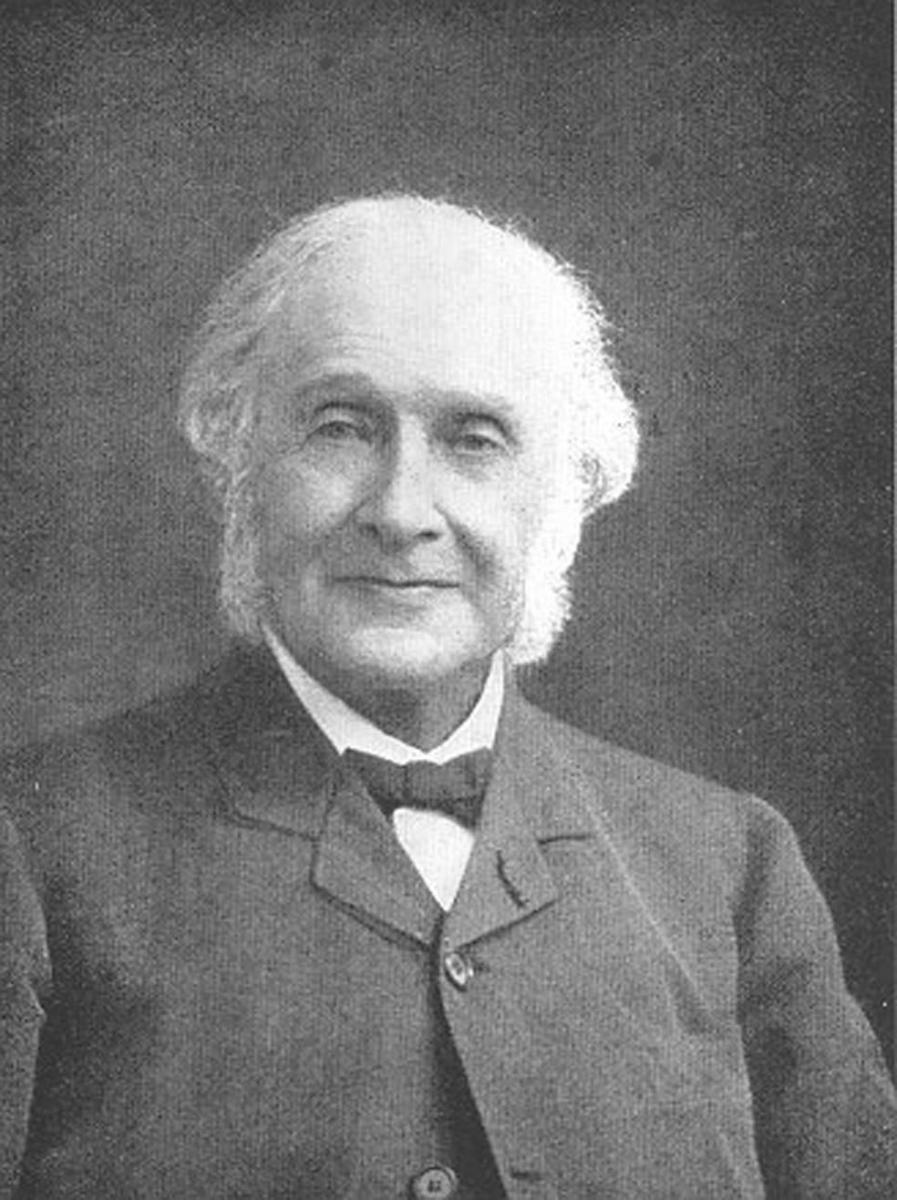
Louis Sautter
Sautter, Lemonnier & Cie. (Pronounced: So-tay - Lemon-yea)
The next step in the evolution of Louis Sautter’s company happened in 1870 when Paul Lemonnier, a civil engineer, became a partner in the business. The company then became known as Sautter, Lemonnier and Cie. The factory of Monsieurs Sautter and Lemonnier manufactured all of the various types of devices relating to lighthouses and to sound signals. Beginning in the 1860s Sautter started the study of the use of electricity and the arc lamp for lighthouse illumination. When Lemonnier joined the firm they began to work closely with the Gramme and De Meritens companies who produced electrical generators and Sautter, Lemonnier sold the generators for use in lighthouses. Sautter would later take over production of the Gramme generator.
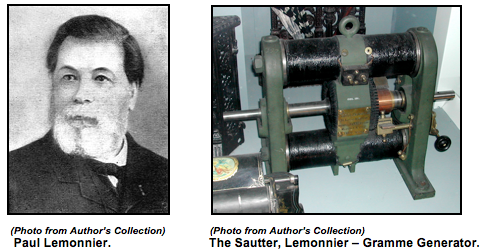
Sautter’s son, Gaston joined the firm in 1878.
Gaston Sautter
Sautter, Lemonnier had sufficient business by 1889 to divide the company internally into three major areas of development: electrical products, optical products and products of a general mechanical nature.
The lighthouse equipment industry was dramatically changed in 1890 when Leonce Bourdelles invented the mercury float to support the rotating Fresnel lenses. This design greatly reduced the friction associated with lens rotation. Production of mercury floats was quickly taken up by the Sautter, Lemonnier factory and it produced nearly all of the early mercury flotation lenses. Sautter saw the potential to significantly speed lens rotation from the previous speed of as little as one revolution every 4 to 8 minutes to 1 or more revolutions per minute. This created what was known as the feux-éclair or ‘lightning light’.
Sautter Harlé (Pronounced: So-tay and Are-L-yea)
In 1869, Henri Emil Harlé, who had married into the Dolfuss family of Alsatian industrialists, started as an engineer in the French Department of Ponts et Chaussees. Harlé resigned from the Department of Ponts et Chaussees in 1890.
The Sautter, Lemonnier Company continued to evolve when Harlé who had become a close friend of Sautter’s son, Gaston, bought into the company in 1890. He became a full partner in the firm, which was now known as Sautter Harlé. Henri Emil Harlé became the joint manager taking over the duties from which Lemonnier had retired in 1890; and his association with Sautter increased the company’s capital by over 2 million francs.
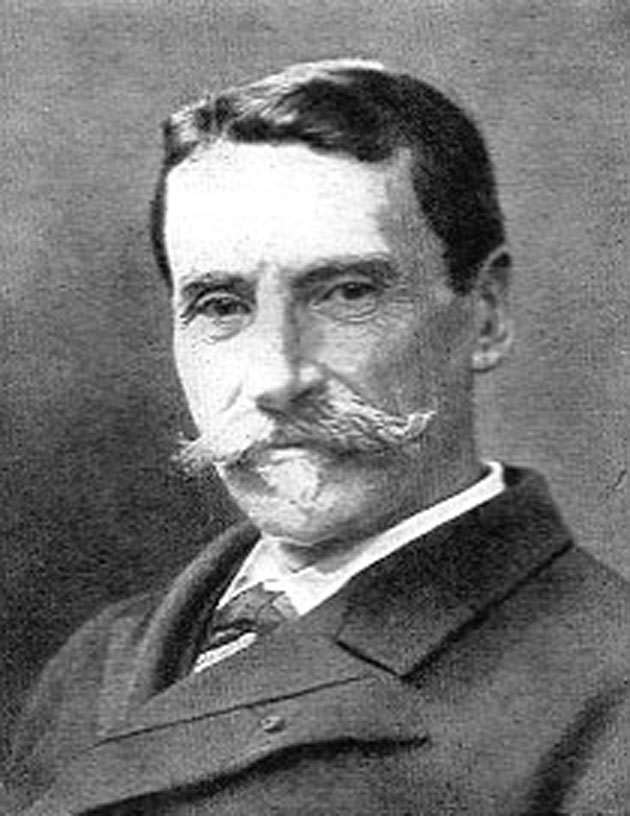
Henry Emil Harlé
Sautter Harlé’s chief engineer, Jean Rey, was a specialist in the design of lighthouse lamps and was responsible for the perfection of the incandescent oil vapor lamp in the late 1890s and early 1900s. At this time Sautter Harlé also entered the railroad signal business. For a short time, from 1910 to 1915, the company was known as just Harlé et Cie.
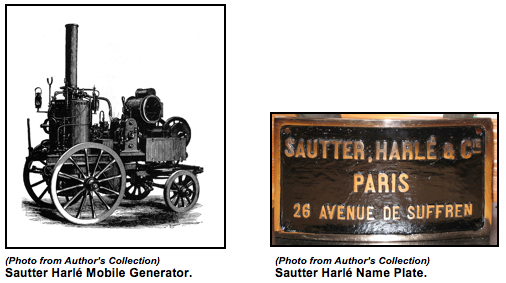
The Sautter Harlé Factory on Avenue Suffren ca 1900
Searchlights
The first searchlight with an optical lens made by Louis Sautter had illuminated the Champs-Elysées in honor of Napoléon III in 1867. It lit the whole upper terrace of the Arch de Triomphe. By the end of the 1800s searchlights had become one of the major parts of Sautter’s business.
The power of searchlights was dramatically increased with the invention of the Mangin mirror that combined the effects of two spherical surfaces, the outer formed with a large radius ‘A’, the inner with a smaller radius ‘B’. Sautter, Lemonnier, after receiving a license from Mangin, created varied models of the Mangin mirror reaching up to l.50 meters in diameter for use in searchlights. During this time, Sautter’s technicians also perfected the arc lamp, steam driven electric generators, and later, the oil vapor lamp to give additional power and range to the searchlights used by the Army and Navy of France.
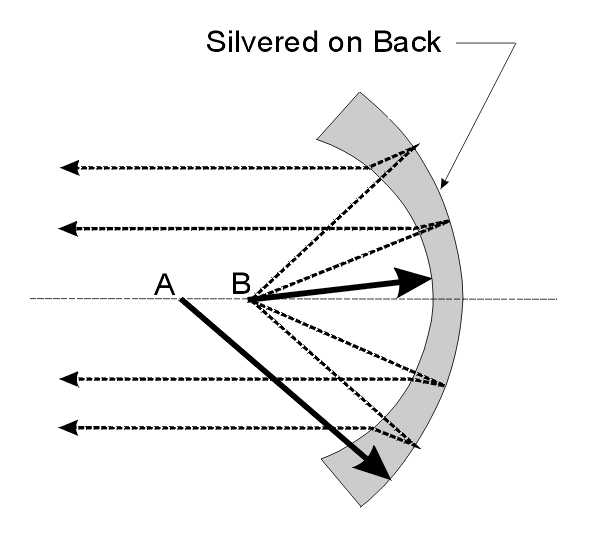
The Design of a Mangin Mirror
As technology progressed, searchlights using a parabolic mirror were developed. The biggest model reached 2.30 meters in diameter. All these mirrors were produced on machines invented and built in the workshops of Sautter Harlé on the Avenue Suffren. Many types of special searchlights were delivered to the principal countries of Europe: military searchlights that were fixed or movable and mounted on automobiles or on trailers, navigation search and signal lights, and searchlights with segmented mirrors that were used for night travel in the areas near the entrances of the Suez Canal.
Harlé et Cie Portable Searchlight for French Military 1911.
In late 1915, the company name was changed again to the Anciens Établissements Sautter-Harlé. (Note: the words Anciens Établissements were not used in the logos, nameplates or stampings of the firm. These words added to a company name mean something similar to our word Incorporated).
Beginning just after World War I, Sautter Harlé converted mainly to the production of large electrical equipment such as electrical generators, compressors, and diesel engines. In 1921, Sautter Harlé began to produce equipment for lighting airports and runways. There was still a very limited production of navigational aids, mostly buoys, until about 1965.
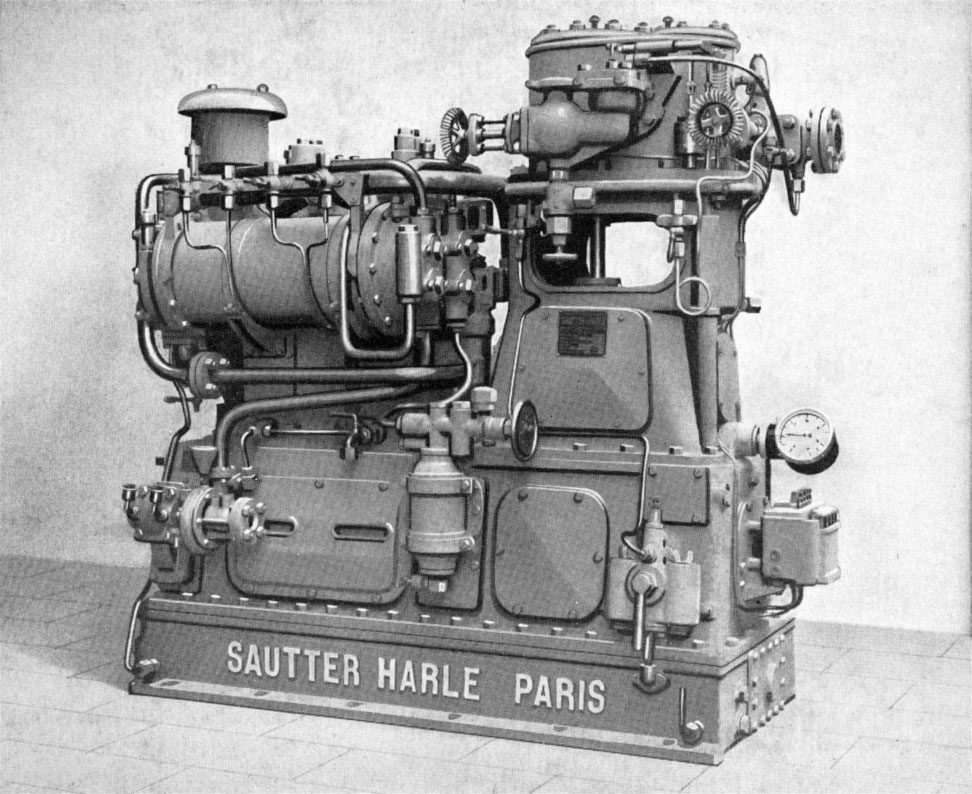
Sautter Harlé Air Compressor 1939.
Sautter-Harlé remained in business until the end of 1969. It was finally absorbed by the Alsthom Company, a French conglomerate, at the start of 1970.
Henry-Lepaute
In this article the Henry-Lepaute Company, in France, is described from its beginnings as a clock maker, to its production of Fresnel lenses for the world market, to its current status.
Henry-Lepaute Lens Works through Time.
Henry-Lepaute Clock and Lens Works
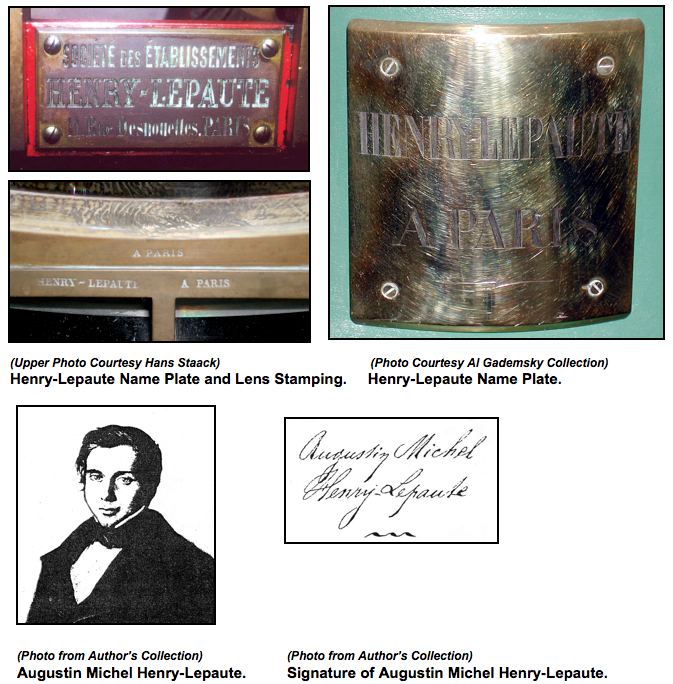
Augustin Henry-Lepaute (Pronounced: On-ree Lua-po-teh)
The founder of the Lepaute dynasty of clockmakers was Jean André Paute, born in 1720 in Thonne-la-Long, France. He was the son of André Paute, blacksmith and maker of plows. André Paute had nine children and two of his sons were Jean André Paute and Jean Baptist Paute.
Jean André Paute had a high level of intelligence and had thought briefly about entering into a religious order as his vocation. However, his passion for mechanics quickly changed his mind and he decided that there was a vocation in working metals, and especially in clock making. He started his career in the countryside where he had grown up, and moved to Paris in order to complete his education. There he established his clock making business, which was an immediate success. He married twenty-eight year old Nicole Reine Ebable, whose father was attached to the Court of Spain. Jean André also invented the peg escapement and became the official clock supplier appointed to the principal observatories of Europe. The Pautes became renowned clock makers and several generations followed in Jean André’s footsteps.
(Drawing from NAWCC Bulletin No. 287 pp. 720) Drawing of a Tower Clockwork by Jean André Paute in 1767.
There was a second family of clock makers in Paris, the Henrys. Augustin Michel Henry lived from 1800 to 1885 and was the youngest son of Pierre Henry and Elisabeth Paute, sister of Jean André Paute and Jean Baptist Paute. Augustin Henry became the successor in the Lepaute clock making business. Augustin married his cousin Anaïs Paute, daughter of Jean Joseph Paute, another member of the family and watchmaker to Napoléon. (Note: In the family records, during the early years, the family name Lepaute and Paute are used interchangeably and only after about 1820 does the family name become firmly ‘Lepaute’).
From 1819 to 1825, Augustin Fresnel, who was then engineer to the French Lighthouse Service, studied the application of clockwork movements for the rotation of the optics in lighthouses. The rotation of the optics had to be very precise to assure that the mariner would see the same timing between each flash of the rotating lens; the use of a clockwork driven by a weight seemed indicated. Unfortunately most of the clockwork movements at that time were based on the escapement principal. For a period of two years, the rotation of the optics in Fresnel’s first rotating lens, installed in the lighthouse at Cordouan, was produced by a clockwork escapement device designed and manufactured by Monsieur Bernard Wagner. The considerable inertia of this heavy flashing lens caused jerky movements of both the lens and clockwork, Fresnel concluded that it was an “unceasing cause of deterioration,” especially for optical devices made from glass, which were much heavier than the reflectors used at Cordouan during the previous thirty years.
Fresnel wanted to use a device with continuous rotation, without an escapement system, and began a search for a new clockwork design.
According to the writings of Augustin Henry’s sons, Fresnel and Augustin Henry met during the opening of the new breakwater constructed in the harbor of Dunkerque in 1824, where Henry had just installed a new bell tower. Fresnel explained the problems with the escapement clock drive to Augustin Henry. Within a few months Monsieur Henry created a new clock mechanism that, while preserving the main workings of his clocks, was supplied with a regulator based on centrifugal force. This was the kind used by James Watt for steam engines; it allowed the clock to maintain a continuous rotation with sufficiently regular speed for the needs of the lighthouses.
On February 11, 1825, Augustin Henry executed his first clockwork equipped with the new design that he called the “flying pendulum”. Augustin Fresnel wrote about the new regulator, stating: “The testing of the first machine with a flying pendulum was done in front of the Commission of the Lighthouses on March 25 1825; but the inventor of the new regulator was not sure enough to make it the final application.” It took several months of testing before Augustin Henry would commit to the use of the “flying pendulum,” but ultimately he introduced it into all the clockworks he produced that were used for lens rotation within lighthouses. The Wagner escapement clockwork at Cordouan was replaced in 1825 with the new Augustin Henry clockwork design.
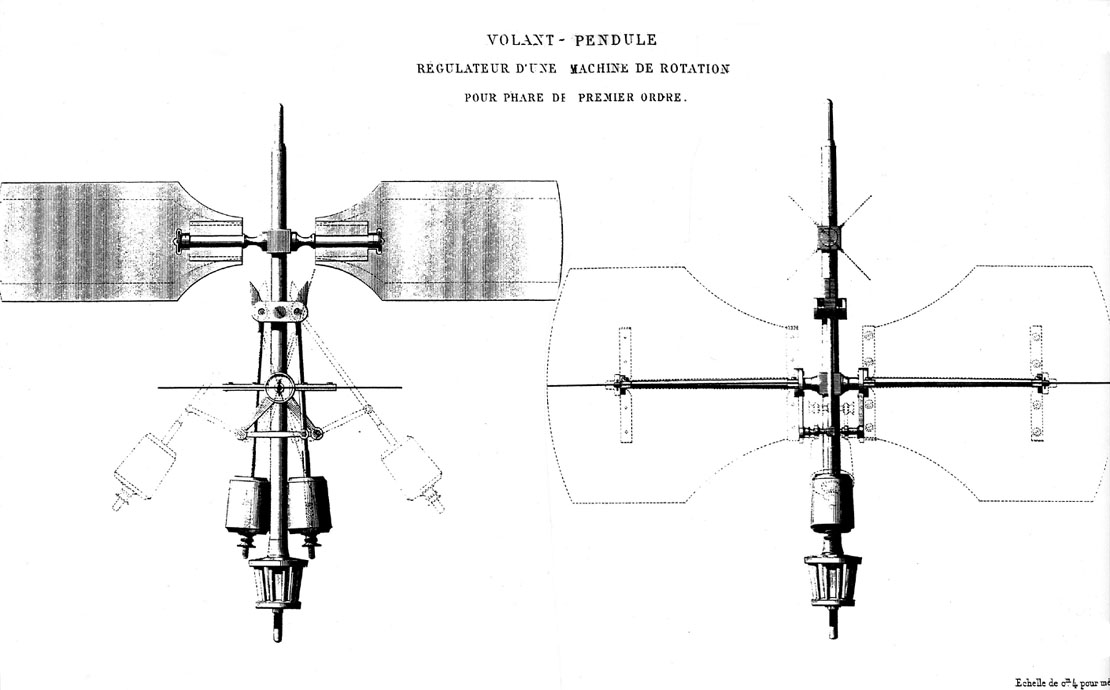
(Drawing from Oeuvres Completes de Fresnel) The Flying Pendulum design of Augustin Henry.
After the death of Augustin Fresnel in 1827, Leonor Fresnel asked Augustin Henry to undertake a survey of the manufacture of lighthouse optics. It was through this survey that Augustin Henry became interested in the construction of Fresnel lenses in addition to the clockworks used to rotate them in lighthouses. The Henry lens factory was a founded in 1838 and built next to the old Lepaute clockwork manufacturing buildings.
In early 1838, Augustin Henry made a bid, with the support of the engineers of the French Department of Bridges and Roads, on an order for manufacturing the lens and clockwork for the Spanish lighthouse of Santander; this appears to be the first lens he manufactured. Another of the early orders received by his new factory was for two lenses for America. In early 1838, Congress had approved a trial of Fresnel lenses and sent Naval Captain Perry to Paris to meet with Augustin Henry, who by this time was unofficially calling himself Henry-Lepaute. Captain Perry ordered a first order lens originally intended for the Isle of Shoals lighthouse and a second order lens originally intended for the Sandy Hook lighthouse. These lenses were shipped at the end of 1839 and were delayed for many months during shipment. Finally in early 1841, Augustin Henry sent a trained workman to install the lenses and train the keepers in their operation and maintenance. Note: These Fresnel lenses became the first installed in America, and due to the shipping delays, were actually installed at the Navesink Lighthouse in New Jersey, -- the first-order lens in the south tower and the second-order lens in the north tower.
Another of Augustin Henry’s trained clockmakers (Stanislaus Fournier) was sent to New Orleans in 1841 with a special tower clock destined for the Saint Louis Hotel. After installing the clock, Monsieur Fournier decided to stay in America and became a famous clockmaker here in the 1840 – 1870 time period.
Léonor Fresnel suggested that Augustin Henry should associate himself with the new glass works at Prémontré instead of the Saint Gobain Glass Company used by the Jean Jacques François lens factory. Augustin got the glass for his early designs from Prémontré, but soon had to deal with Saint Gobain when it bought Prémontré Glass in 1843.
The Henry lens factory had relationships with both the Jean Jacques François lens factory and later with the Létourneau lens factory. In addition to his work on lens design and manufacture, Augustin Henry continued to work on clockworks with continuous rotation and also on the clockwork that powered the four-wick Fresnel lamps. The lens designs and updated manufacturing tools and methods of Henry-Lepaute allowed for the manufacture of larger curved prisms and dioptric rings, thus reducing the number of individual pieces of glass in each lens.
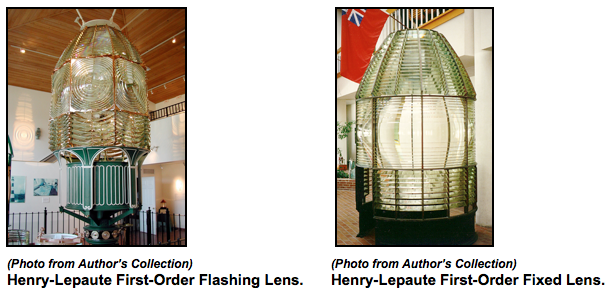
Napoléon III allowed Augustin Henry to officially join "Lepaute" to his name, so in 1854 he became known as Augustin Michel Henry-Lepaute. At the same time the factory was renamed Henry-Lepaute.
In 1861, Monsieur Reynaud, Director of the French Lighthouse Service, stated that: “The administration always desires to maintain two construction establishments for lighthouses in Paris (on a plan of equality) and therefore distributes the work as equally as possible.” However, he also acknowledged his preference for the devices produced by Henry-Lepaute, because his devices were more perfect in execution than those of Sautter, Lemonnier et Cie. The American Lighthouse Board split its lens purchases roughly fifty-fifty between Henry-Lepaute and Louis Sautter during the main conversion to Fresnel lenses. In the years 1853 through 1860 it purchased 336 Fresnel lenses from Henry-Lepaute.
During the 1860s, Henry-Lepaute began to sell electrical generators and arc lamps for lighthouse use. However, it purchased most of the electrical equipment from other suppliers. Later, the creation of the French railroads forced Henry-Lepaute to begin work on the use of electricity to both drive and regulate clocks and networks of clocks specifically designed to maintain the exact same time in the many railroad stations around France. The application of electricity to the clock was not new. The first electric clock was developed in the city of Bath, England in 1840. Many tests of electric clocks had been made, but few electric clocks were then in use.
The successors to Augustin Henry-Lepaute were his sons Léon and Paul. Léon, the eldest, was made particularly responsible for the manufacture of equipment for lighthouses, and Paul was responsible for the manufacture of clockworks. Sometime after the 1860s the factory was renamed Henry-Lepaute & Sons. Until 1896, the House of Lepaute was controlled by the two brothers, and at the end of this era the Establishment - Henry-Lepaute was founded. Still later, Henry-Lepaute’s grandsons Andre and Marcel took over operation of the factory. Throughout its existence the Establishment - Henry-Lepaute remained family owned and operated.
Henry-Lepaute did not manufacture complete lighthouse towers or the major heavy metal assemblies and instead contracted with the Schneider Company when such elements were required as a part of the contract.
During the First World War, the Establishment Henry-Lepaute worked exclusively for the French national defense. Further development of the electric clock had to be abandoned, and at the end of the war, it was found that the Henry-Lepaute clock designs were greatly out of date due to other French and foreign competition. However, the Establishment Henry-Lepaute quickly reentered the field of electric clocks, as well as other areas of electronics, and became leaders in the field of small electrical instruments. It continued to perfect a series of master slave clock networks where a master clock sent signals over telephone lines to other slave clocks, which were then forced by the master signal into coordinated operation.
On March 27, 1952, a fire occurred during the lunch hour in the factory of the Establishment Henry-Lepaute, located on Desnouettes Street in Paris; the fire was of such proportion that, in less than a quarter of an hour, all the workshops were almost completely destroyed. The local newspaper reported that: “The workmen who were just returning to work from the lunch hour immediately began, despite the danger, to save anything that could be saved. The office files, small equipment, clocks, the finished devices nearly ready to be delivered, and also, as if it was a piece of their own heritage, the portraits of Lepaute’s forbearers, which hung on the walls of the managerial offices and all the relics of the company’s glorious past, which had been accumulated over more than two centuries.”
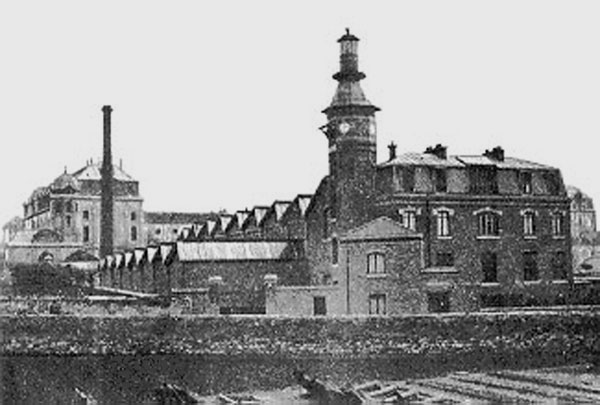
The Factory on Rue Desnouettes in Paris.
The company was rebuilt as a smaller enterprise at a new location, Littre au Mesnil-le-Roi, near Paris during 1952 and was fully functional by 1955. At this time, Fresnel lenses were no longer made.
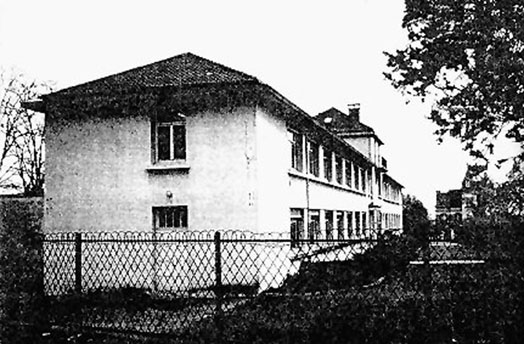
The Factory at Littre au Mesnil-le-Roi, near Paris.
After 1955, the Henry-Lepaute factory’s major products were electric clocks, the ‘Vibrograf,’ which is a highly advanced watch-timing machine still in use today, and its railway and other clock networks. The Vibrograf included an early electronic printer that produced line graphs. Business continued at the Littre au Mesnil-le-Roi location until 1960 when the company further downsized and moved to 15 Rue Aubepines, in Orly near Paris. The company remains in business today. Until 1972, it was under the direction of Michel Henry-Lepaute, the last clockmaker of the Henry-Lepaute dynasty. It currently makes a line of electric clocks and small office equipment.
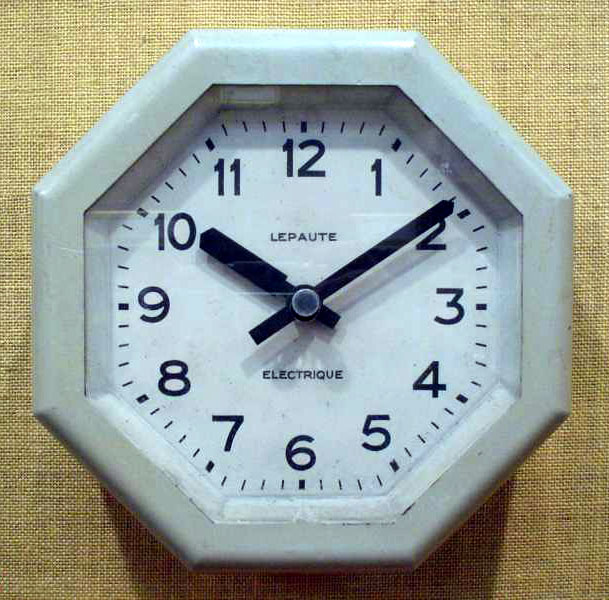
Henry-Lepaute Electric Clock.
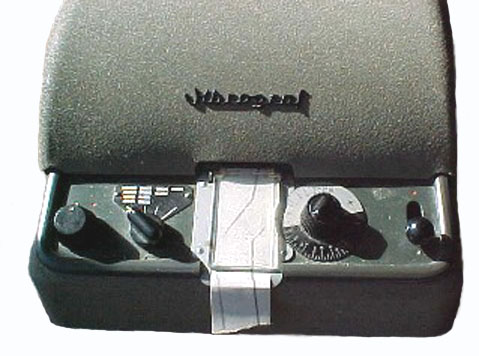
The Henry-Lepaute Vibrograf.
Chance Brothers Glass and Lens Works
This is a continuation of the story of the Fresnel lens makers. In this article the Chance Brothers Company, in England, is described from its beginnings as a glass window maker, to its production of Fresnel lenses for the world market, and to its final demise when it was bought out and divided into several companies.
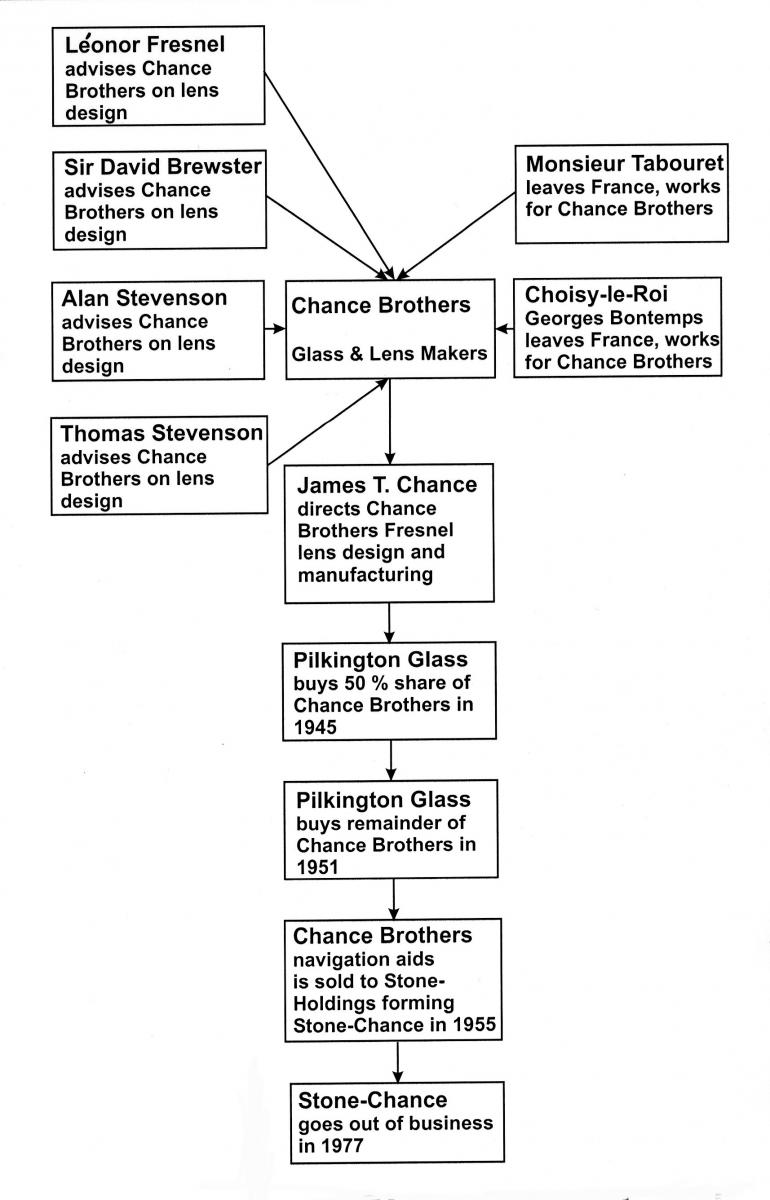
(Chart by Author) Chance Brothers Glass and Lens Works through time.
Chance Brothers Glass Works
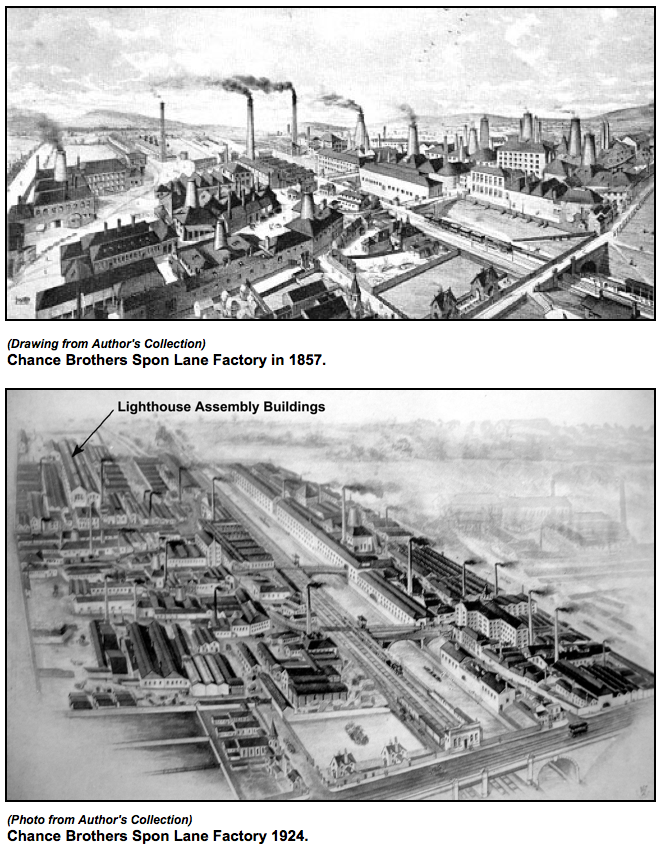
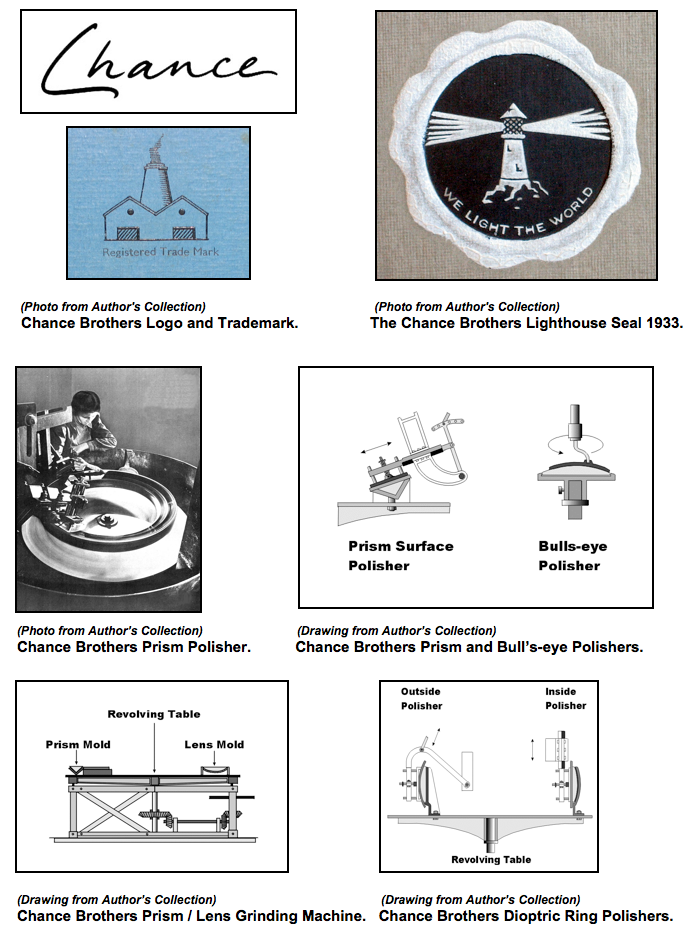
The History of Chance Brothers Glass Works
This story begins in some confusion due to the usage of the same or similar names by a number of interrelated people in the Chance and Lucas families. In 1793, John Robert Lucas, William Chance and Edward Homer formed a partnership and purchased a glass works located in Wick, near Bristol, England. This glass works soon grew and a second factory was built in Nailsea, England. Robert Lucas Chance, William’s son, who was known just as ‘Lucas’, became a partner in the firm in 1804 and took over management of the Nailsea factory in 1811. He left the firm in 1815 and became a very successful glass merchant in London.
Lucas Chance, in addition to his glass merchant business, purchased one of the factories of the British Crown Glass Company on May 18, 1824. This factory was located in Smethwick, England. Lucas tried to operate his new factory on his own, but found he could not devote his full time to glass making. On April 1, 1828 he formed a partnership with John Hartley who was reputed to be the leading crown glass expert in England. John Hartley and his son James were then given the management responsibilities for the Chance & Hartley factory in Smethwick. Chance & Hartley became associated with the Choisy-le-Roi glass factory, in France, after Lucas Chance made a visit there in 1830. By 1832, Monsieur Bontemps (Pronounced: Bon-tohm), Director of Choisy-le-Roi glass, was asked to advise Chance & Hartley on the manufacture of sheet glass for use in windows and to supply a number of French workers knowledgeable in its manufacture. This was the beginning of a long relationship between Lucas Chance and Monsieur Bontemps. In 1832, Lucas quit the merchant glass business to devote all his energies to his glass works in Smethwick. At this time, Lucas’s brother William bought into the firm and became a partner. John Hartley died on August 15, 1833 and his place was taken by his two sons, James and John Jr., and the firm name was changed to Chances & Hartleys. In November 1836, after the Hartleys sold out, the company name was changed to Chance Brothers & Co. William’s son, James Timmins Chance, joined the firm on January 1, 1839, and became the firm’s expert on manufacturing techniques, and in time, on Fresnel lens development.
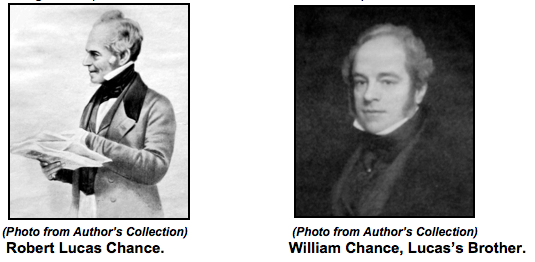
The French glass industry held a significant lead over the British in the manufacture of window or sheet glass during the early years of the nineteenth century. However, the French workers brought into Chance Brothers in 1832 started a revolution in Chance Brothers manufacturing processes, James Timmins Chance contributed with the design of a grinding machine that could grind both surfaces of a piece of sheet glass at the same time, drastically reducing the time and cost to produce sheet glass for windows. Sheet glass was made by the workers blowing long glass cylinders that were then slit up the side while still hot and laid on a metal table to flatten. Once flattened and cooled, the sheets of glass were ground to form flat panels of window glass approximately 2 feet by 3 feet in size. By 1848, Chance Brothers was the largest producer of sheet glass in Britain and successfully bid on the contract to produce all of the glass for the Crystal Palace then about to be built. In all, Chance Brothers supplied over 956,000 square feet of sheet glass for this project.
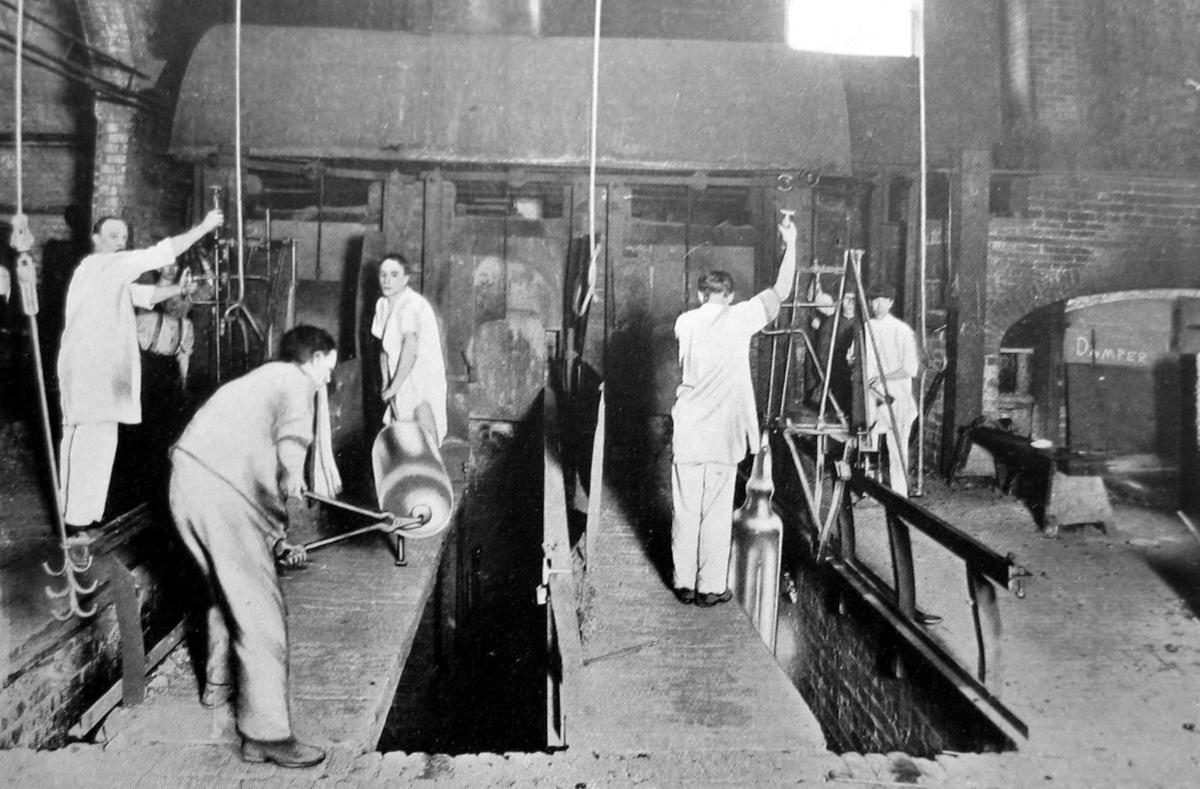
Making the cylinders from which the sheet glass was produced.
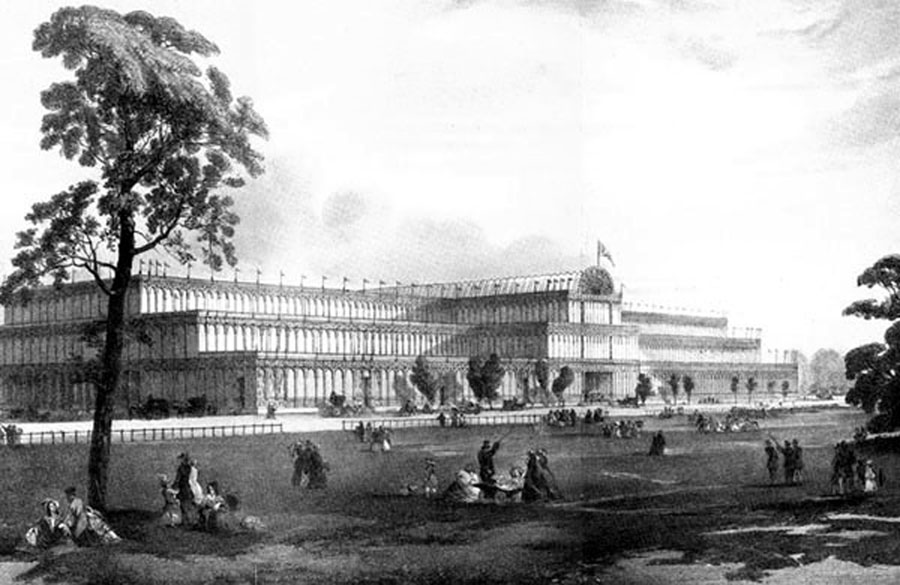
The Crystal Palace in 1851.
Chance Brothers invented a special process that allowed it to produce extremely thin glass for use in microscope slides and microscope cover-glasses in 1840. For over forty years Chance Brothers was the only supplier in the world of this glass and remained the only supplier in England for an additional sixty years.
In 1848, Chance Brothers hired Georges Bontemps to assist them in the further development of true optical quality glass. Bontemps resigned from Choisy-le-Roi and moved to Smethwick where he assisted in setting up the manufacturing processes needed for optical glass used in making lenses for astronomical telescopes and for the near optical quality glass necessary for the production of the dioptric elements and prisms in Fresnel lenses.
In 1887, Edmond Feil, owner of a small optical glass factory in France, wrote to Chance Brothers and offered to sell them the processes and ingredient formulas for many types of optical and near optical quality glass then produced only in France and Germany. Chance Brothers accepted Edmond’s offer and purchased drawings of various glass making tools and molding equipment, as well as all of Edmond’s, formerly secret, glass formulas.
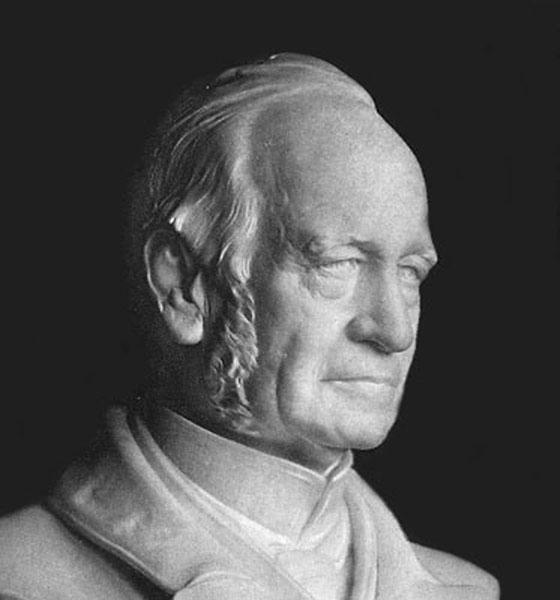
James Timmins Chance.
Between 1885 and 1895 Chance Brothers worked on the design of new equipment for the production of rolled glass, using rollers both above and below the glass. The new machinery allowed a dramatic increase in production. The new process was so successful that Chance Brothers licensed its use to the Saint Gobain Glass Company in France. This led to the purchase of a portion of Chance Brothers stock by Saint Gobain in 1912, and the two companies then began joint development of a number of projects. Chance Brothers also bought a glass company located in Glasgow, Scotland in 1907 and produced much of its rolled plate glass for windows there from that time on.
From 1848 until the start of World War I, Chance Brothers was the only maker of true optical quality glass in England. After the war other companies entered the field, but it was still dominated by Chance Brothers. In 1932, Chance Brothers bought the Parsons Optical Glass Company to further expand its product line.
In 1930, Chance Brothers entered the field of electrical equipment manufacture and in 1939 began the production of Sumo Pumps. It later acquired the electrical firm Austinlite and expanded its business in traffic signal, electrical generation, and switch manufacturing.
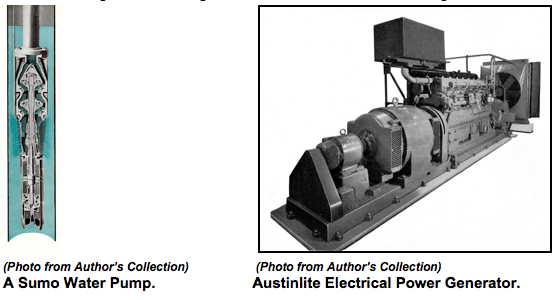
During World War II, Chance Brothers supplied optical glass for many military applications such as: search lights, periscopes for tanks, airport lighting equipment, submarine periscopes, anti-aircraft range finder optics, mechanical computer parts used in the anti-aircraft ‘Predictor,’ CRT tubes for RADAR monitors, and it continued to produce railroad signal lenses and many types of laboratory glass. By the late 1940s, Chance Brothers was producing picture tubes for television sets and the glass tubes needed for fluorescent lighting.
Just before World War II in 1939, Chance Brothers was asked by the Admiralty to create a second ‘shadow’ optical glass factory to be located next to the Pilkington Brothers Glass factory in Saint Helens, England. Chance Brothers built and managed the new operation, known as the Umbroc Company, with the help of Pilkington and its workers. The Pilkington Brothers Glass Company was so impressed with Chance Brothers manufacturing processes and management that it acquired a 50 percent share in Chance Brothers in 1945; by 1951, Chance Brothers became a wholly owned subsidiary of Pilkington.
Pilkington was then the largest window glass firm in England and it decided to close the window glass manufacturing operations of Chance Brothers. In late 1945 and throughout 1946, many of the Chance Brothers buildings and furnaces were shut down and demolished. This left lighthouse lens and other navigation aids, the chemical plants, glassware, CRT tubes, and true optical glass manufacturing as Chance Brothers’ only products. At this time Chance Brothers also decided to end its optical glass manufacturing at Smethwick and move all production to the former Umbroc plant collocated with the Pilkington factory in Saint Helens. Chance Brothers remained in business until late 1954 when the navigation aids portion of the company was purchased from Pilkington by Stone Holdings, becoming the Stone-Chance Company at the start of 1955. The true optical glass portion of what had been the Chance Brothers Company was combined with the optical glass division of the Pilkington Company in 1957, forming the Chance-Pilkington Optical Works and was moved to St. Asaph in North Wales.
Chance Brothers had always been a worker-oriented company. It had many programs to benefit its employees, including a convalescent home, youth club, sports field, etc. It also made a habit of employing handicapped workers and youths as young as 14. Chance Brothers also was a serious benefactor to the local community with projects such as the Chance Technical College and West Smethwick Park that was built by James Timmins Chance.
(Photo Courtesy Margaret Evans) Chance Technical College.
(Photo Courtesy Margaret Evans) The Main Gate House of Chance Brothers Works – Smethwick, West Midlands.
Chance Brothers Lens Works
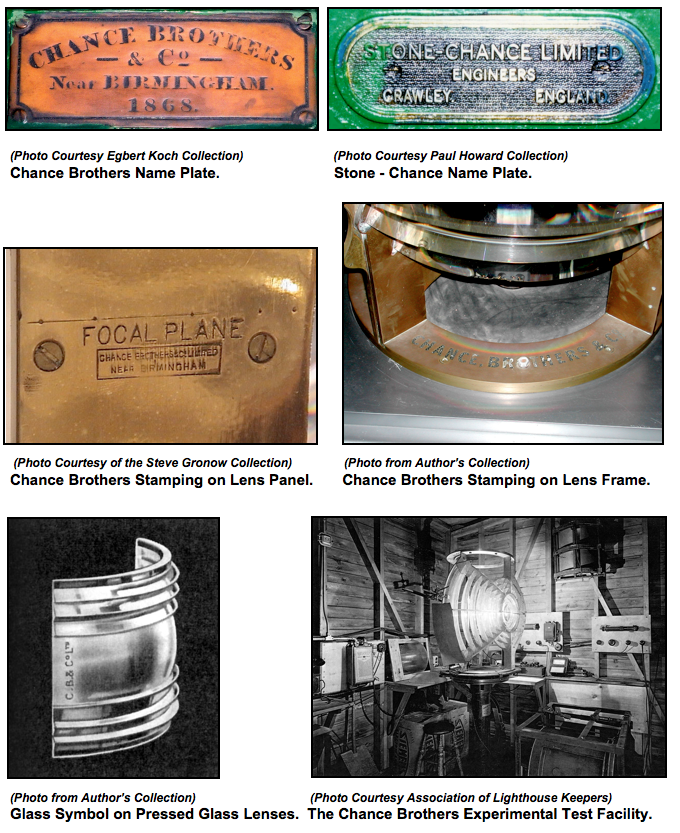
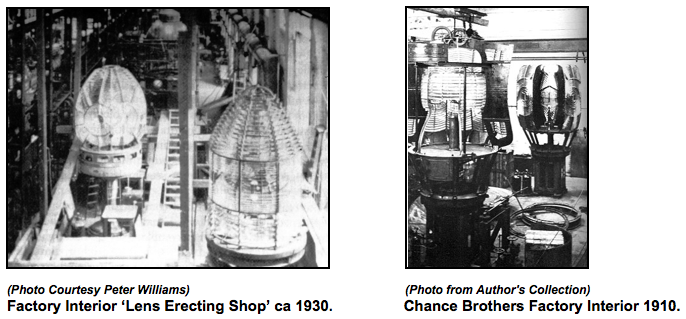
In 1845, at the request of Sir David Brewster, Chance Brothers decided to attempt the design and construction of a Fresnel lens. It engaged the services of Monsieur Bontemps in April 1848, for the production of optical and colored glass. It also brought in another French expert, Monsieur Jacques Tabouret, who had been employed for more than thirty years by the Lighthouse Service within the Department of Ponts et Chaussées, in France, and had personally worked for Augustin Fresnel. Monsieur Tabouret assisted Chance Brothers in the design and manufacture of its first Fresnel lens.
With Bontemps’ expertise, Chance Brothers began to produce limited quantities of near optical quality glass. Chance Brothers glass was purposely made quite hard in order to resist corrosion by the atmosphere. The glass had a pronounced greenish tinge, but its quality was equal to or better than the French lens glass in regard to striae. Monsieur Tabouret constructed a lens of the first order, which was shown in the Crystal Palace at London’s Great Exhibition of 1851. Alan Stevenson went to Chance Brothers to see the lens and stated: “they have fine work and work beautiful frames, but the glass is green – very green.” After the close of the exhibition the lens was sent to Singapore. True production of Fresnel lenses of various sizes did not occur until late in 1855 at the completion of the Paris Exhibition of that year.
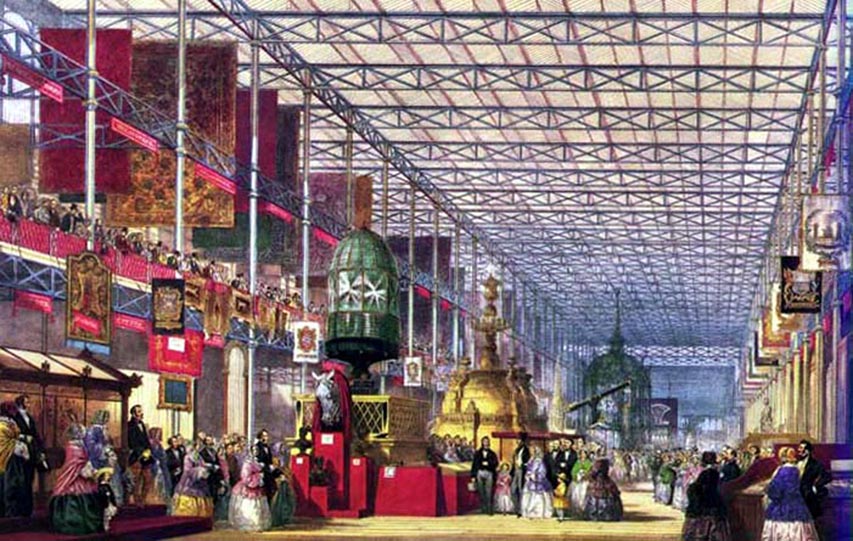
Interior of the Crystal Palace showing the Chance Brothers first-order lens.
In 1852, a new furnace was built especially to produce glass for use in Fresnel lenses. It consisted of four pots that were covered. All raw materials used in this furnace were specially selected and of the highest grade and quality available. This allowed the production of lens glass with a lessening of the green color tinge normally seen. The crown glass produced in this furnace also contained fewer bubbles and striae, nearing true optical quality. By 1860, another special furnace was used to produce ‘extra white’ glass that could be used to manufacture lighthouse lenses. Further improvements were made in lens glass in 1865 when extensive efforts were made to remove all trace iron from the glass and especially from the soda used in the glass. Chance Brothers produced an extra-refined salt cake in its alkali plant specifically for Fresnel lens glass production. This further reduced any remaining green color in the glass.
The Chance Brothers Pot Setting Machine designed for use with the special Fresnel lens glass furnace.
During the period from 1855 through about 1885, Alan, and later, Thomas Stevenson, engineers to the Northern Lighthouse Board in Scotland, consulted heavily with James T. Chance on the design of various types of lighthouse optics. Many new and varied designs were proposed by the Stevensons -- from the holophotal lens-reflector combination to lenses for ‘apparent lights’, condensing lenses, rear totally reflecting prism mirrors, and the Hyper-Radial lens. During the early part of this time period, James T. Chance was assisting Trinity House in a review of all of its currently installed lenses. James found that the installed lenses, originally made by the French lens companies, had not been manufactured for the specific lighthouse locations and elevations where they were located. This resulted in the lenses sending their light in various directions and not necessarily to the horizon. Through James Chance’s efforts, each lens was readjusted and major changes were made in how lenses were specified and procured by the various British Lighthouse Authorities. From that time forward, Chance Brothers manufactured each of its lenses pre-adjusted for a specific location, resulting in significant improvements in the light output.
Chance Brothers also produced various prefabricated lighthouse towers. It created a standardized cast-iron tower that was test assembled at the factory and then dismantled and shipped to the final destination to be reassembled. It also produced skeleton towers for use as pierhead and port lights.
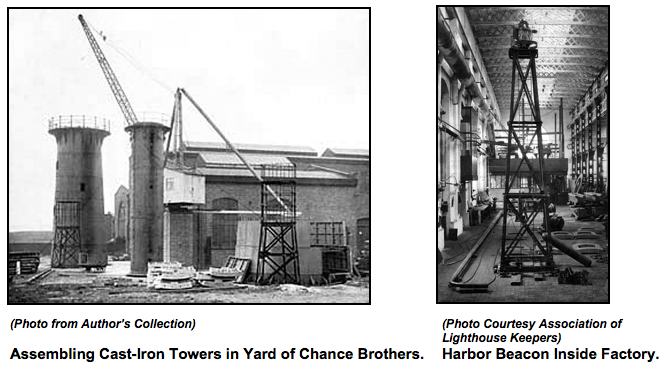
Chance Brothers also produced many types of components for lightships, including complete lightship lantern-rooms. They also produced several types of fog signals.
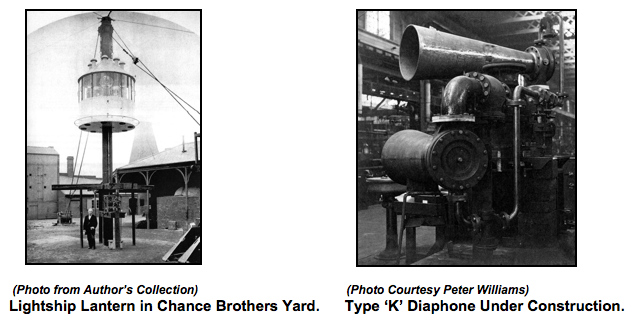
In 1872, Chance Brothers hired Dr. John Hopkinson as its scientific advisor and chief engineer. Also in 1872, Chance Brothers began the design and production of clockworks to drive the rotation of the lenses within lighthouses. Previous to 1872 they purchased all their clockwork assemblies from outside suppliers. Their clockwork design evolved into a unique style that was significantly easier to build and maintain than the clockworks produced by other suppliers. In 1879, Dr. Hopkinson took over the management of the lighthouse works.
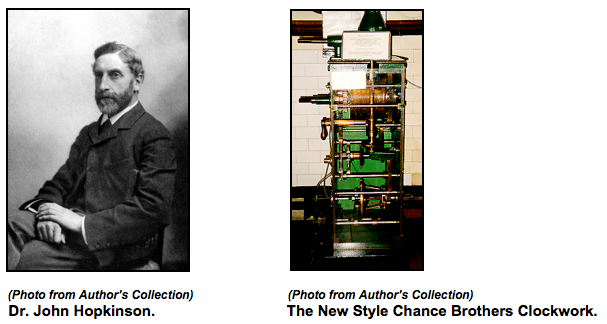
Dr. Hopkinson instituted many technical improvements in the design of Chance Brothers products with his major advance being the ‘Group Flashing’ design for Fresnel lenses completed in 1874. Group Flashing lenses produce a light in which the flashes are combined in groups, each including a specified number of flashes, and in which the groups are repeated at regular intervals. The eclipses separating the flashes within each group are of very short yet equal duration, and are shorter than the duration of the eclipse between two successive groups.

Another design by Dr. Hopkinson, first produced in 1880, removed the outermost catadioptric reflecting prisms and replaced them with refracting-only prisms made of dense flint glass to allow greater angles of refraction in these first order and larger lenses.
4-Flash, 1st Order, Group-Flashing Lens with outer refracting prisms made of flint glass.
Dr. Hopkinson also improved the design of the pedestal and mercury bath that supported Chance Brothers Fresnel lenses and invented the tapered rollers that replaced the old style chariot wheels previously used to support the lens and allow it to rotate. Chance Brothers produced their first mercury bath in 1895 for the Cape Leeuwin Light in Australia.
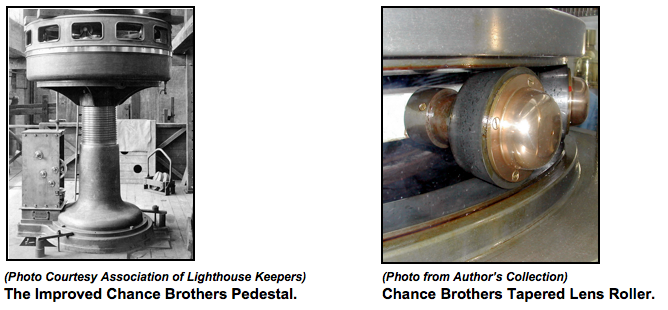
Chance Brothers took the design of the Incandescent Oil Vapor (I.O.V.) lamp that had been invented in France in 1898, and improved its design starting in 1904.

At this time Chance Brothers, with input from Trinity House, created a very distinctive design for its lantern rooms. It used a large cylindrically-shaped drum ventilator to replace the ball design previously used.
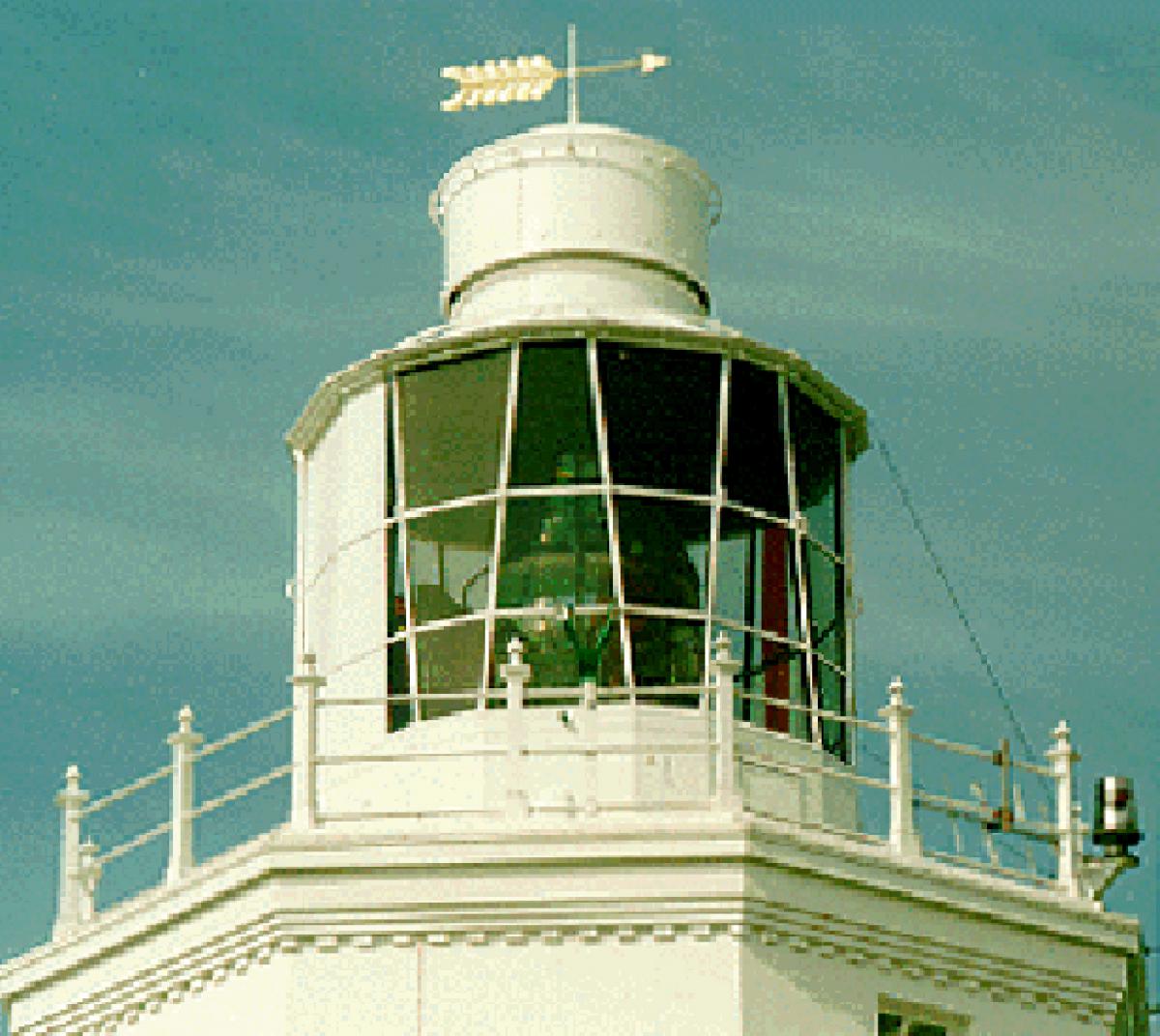
Chance Brothers Distinctive Lantern Design.
Tragically, Dr. Hopkinson and his family were killed in an accident in the Alps Mountains in 1898.
Chance Brothers continued its innovative lens, clockwork, and rotation designs and became the major lighthouse equipment supplier to many parts of the world. The American Lighthouse Board bought its lenses mostly from the French companies until about 1890 when a few Chance Brothers lenses and other equipment were purchased.
Chance Brothers was one of the early producers of the Hyper-Radial lens and began their production in 1887. In all, Chance Brothers is thought to have produced up to 13 Hyper-Radial lenses.
Beginning during World War I and continuing until Stone-Holdings took over in 1954. Chance Brothers produced equipment for airport lighting, including runway lights and airport beacons, using many Fresnel lens elements in the designs.
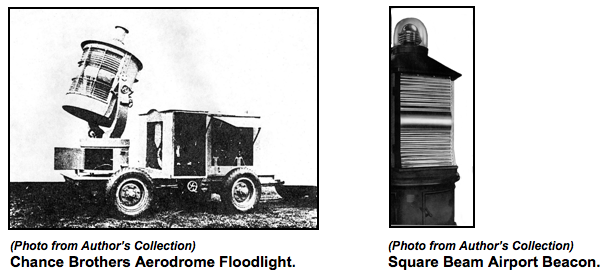
Stone-Holdings bought the navigation aids division of Chance Brothers in 1954, becoming Stone-Chance Limited. Stone-Chance continued in the navigation aids business until it was finally closed and sold between 1975 and 1977, with portions of its products being acquired by AGA Navigation Aids Ltd. (AB Pharos), which was sold in 1984, becoming AB Pharos Marine. You will learn more about these companies in Part 6 of this story.
A Stone-Chance Rotating Beacon with Plastic Lenses.
Pilkington operated what was left of the Chance Brothers factory, in Smethwick, until it was sold and officially closed in 1982. Today many of the former Chance Brothers buildings have been torn down and the remaining buildings are being refurbished and converted into hi-tech office space.
(Photo Courtesy Margaret Evans) Some of the buildings of the former Chance Brothers Factory today.
Barbier, Benard and Turenne
This is a continuation of the story of the Fresnel lens makers. In this article the Barbier, Bénard and Turenne (BBT) Company, in France, is described from its beginnings as a Fresnel lens maker for the world market, to its final demise when it was broken up and merged into several other companies.
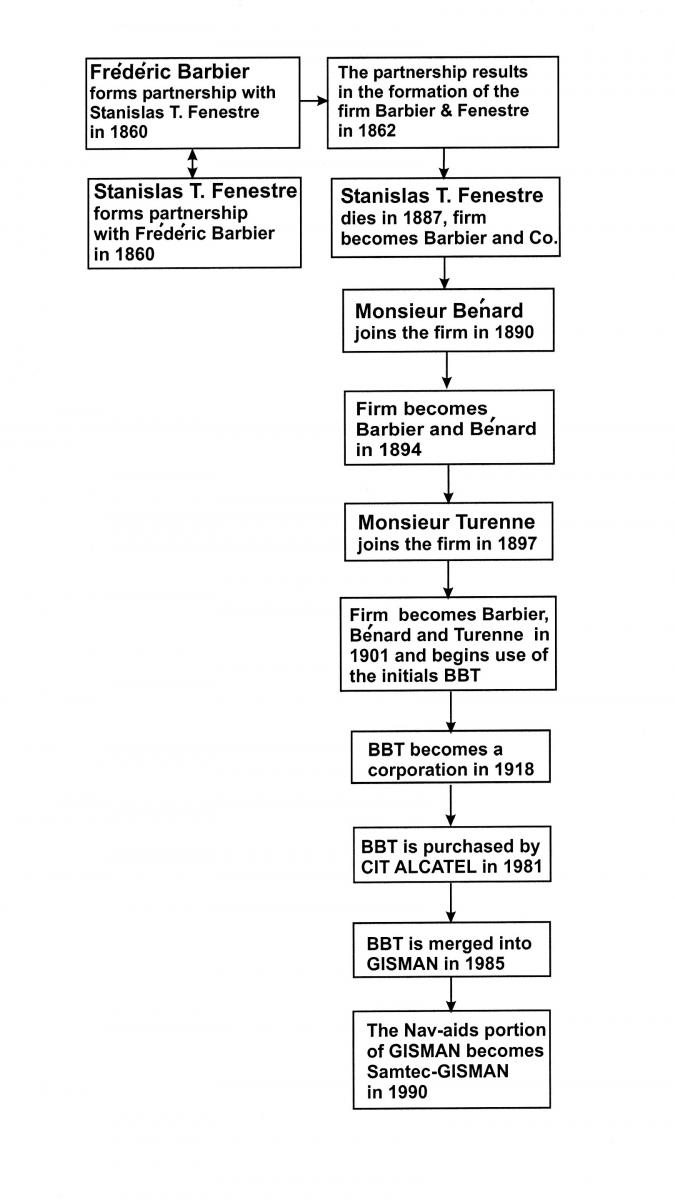
The Barbier, Bénard and Turenne Lens Works Through Time.
Barbier, Bénard et Turenne (BBT) Lens Works
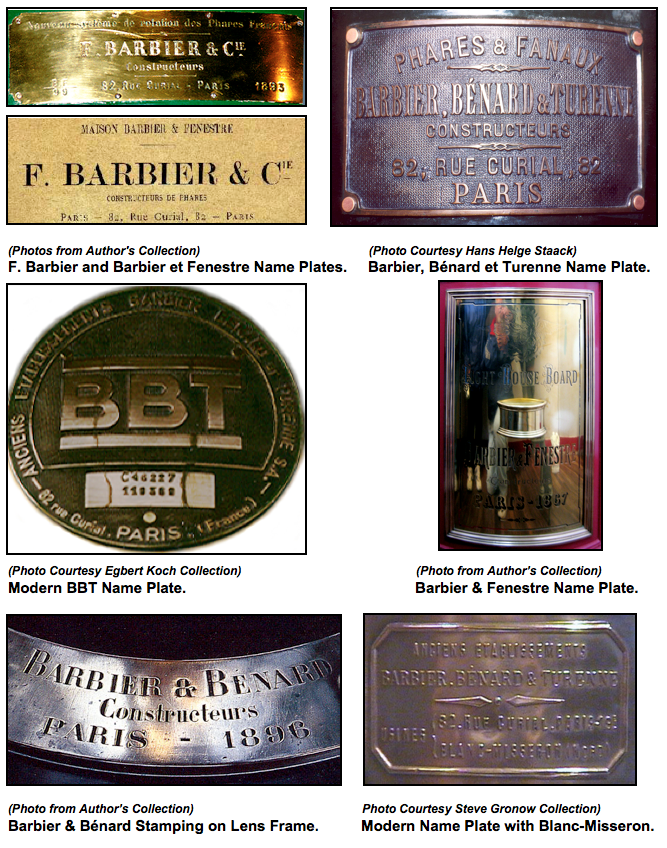
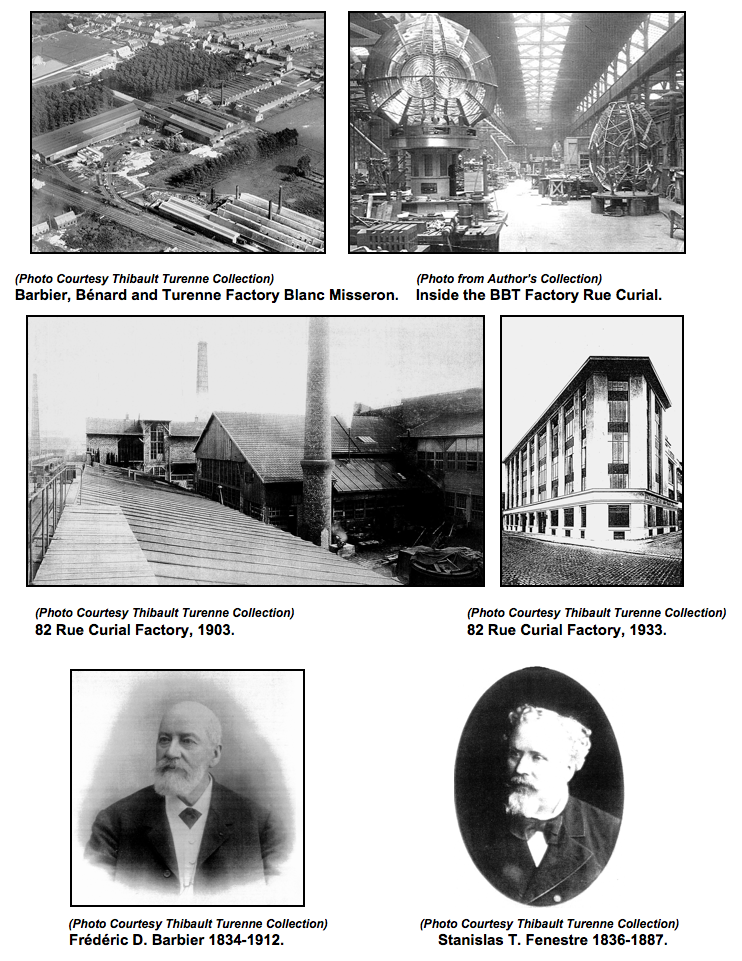
Barbier and Fenestre (Pronounced: Bar-B-yea and Fu-nea-tra)
Nicolas Frédéric Désiré Barbier, known as Frédéric, graduated from the “Ecole Centrale de Paris” as an engineer. He formed a partnership with Monsieur Stanislas Tranquille Fenestre in 1860 and they formed a company on October 6, 1862 to produce lighthouse equipment including Fresnel lenses, lamps, clockworks and many other devices. The new company took the name of its founders, Barbier and Fenestre. A small factory was created in an outbuilding of the land owned by Monsieur Barbier located at 82 Curial Street in the 19th district of Paris. By late 1862, the first products had been shipped and the outbuilding had grown into the head office as well as the manufacturing location of the company; operations continued there for many years.
Barbier and Fenestre became the third French manufacturer of lighthouse equipment then in operation, the others were Louis Sautter and Henry-Lepaute. The competition was fierce and the company soon recognized the necessity of manufacturing all of the constituent elements for a complete lighthouse, including the tower, lantern, clockwork and other equipment, to assure that all of the elements within the lighthouse worked together flawlessly and were of the best possible construction. Providing the complete design package also assisted the capabilities of Barbier & Fenestre to sell its products to the various lighthouse services around the world and to have a product line that could meet and surpass its competition.
Barbier and Fenestre produced its first lens for America, a 4th order fixed lens for the South West Reef lighthouse, in 1862. This was followed by more than 435 additional lenses delivered to the United States Lighthouse Service over the next fifty years.
Barbier and Fenestre first began to look into the development of lenses with a larger focal length in 1872 at the request of John R. Wigham in Ireland. Wigham needed a long focal length lens (bigger than the 1st order) to allow his 108-jet gas burner to deliver the most light to the horizon. Some five years later, in 1877, Wigham went to Barbier and Fenestre and was shown the first drawings of his proposed ‘Hyper-radial’ lens. However, Wigham did not have the political power to get his Hyper-radial lens design actually produced. The Commissioners of Irish Lights were not able or willing to fund this costly new lens design. Finally in 1885, Thomas Stevenson, Engineer of the Northern Lighthouse Board in Scotland, suggested that a larger lens would be useful with the new, larger oil burners being designed by James Douglass for the Trinity House in England. Stevenson and Douglass had political power and both the French and English lens manufacturers were soon given official orders for the Hyper-radial lens. F. Barbier was the first lens manufacturer to produce a Hyper-radial lens panel in late 1885 for the trials then going on at the South Foreland Lighthouse. In all BBT is thought to have produced 14 Hyper-radial lenses. It produced the only Hyper-radial lens used in America, a fixed lens at Makapu’u Point, Hawaii. Barbier also produced the only ‘Giant Lens’ for John Wigham in Ireland in 1892. This lens had a radius of 2000mm or almost one and a half times the size of the Hyper-radial lens.
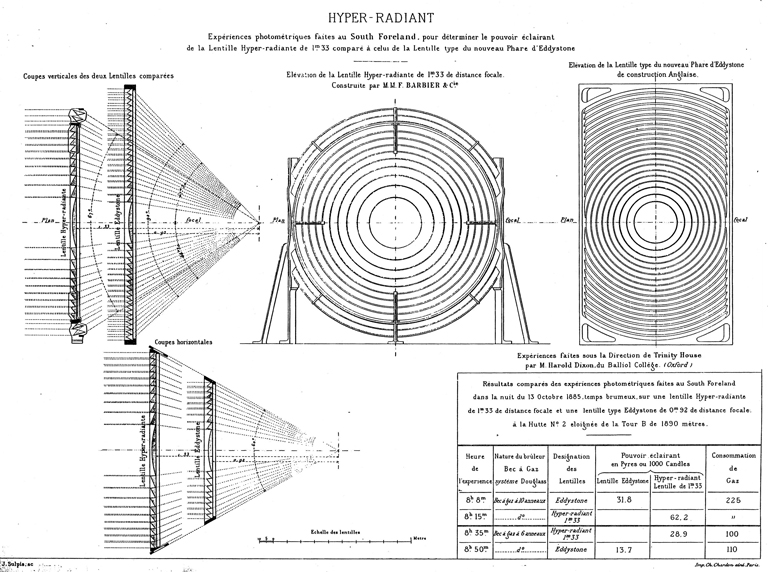
The first Hyper-radial lens panels made by Barbier & Fenestre that were used at the South Foreland Trials.
Makapu’u Point Hyper-radial Lens by F. Barbier.
In the 1880s, Barbier and Fenestre bought the exclusive European rights to the Courtenay Whistling Buoy from J. M. Courtenay in America. It produced variations of the Courtenay buoy for more than fifty years.
Courtenay’s Whistling Buoy.
Barbier et Cie. (Pronounced Bar-B-yea)
Stanislas T. Fenestre died in 1887 and the company name was changed to Barbier et Cie. They also used F. Barbier on their nameplates during this period. Note: Nicolas Barbier apparently did not like to use the name Nicolas and mostly used only his second initial ‘F’ or Frédéric. The company remained at 82 Rue Curial in Paris.
Barbier and Bénard (Pronounced Bar-B-yea and Beh-nar)
Barbier et Cie. was short lived. Frédéric Barbier had four daughters and his daughter Louise married Joseph Bénard in 1890. Monsieur Bénard joined the firm and the company name was changed to Barbier and Bénard by early 1894.
(Photo Courtesy Thibault Turenne Collection) Joseph Bénard 1865-1944.
Barbier, Bénard et Turenne (BBT) (Pronounced: Bar-B-yea, Beh-nar and Two-renn)
Paul Turenne joined the firm in 1897. He married another of Barbier’s daughters, Lucie, in 1901. The company then became known as Barbier, Bénard & Turenne. The three letters (BBT) were first used in 1901, although the complete company name, Barbier, Bénard et Turenne, continued to be used on the company’s lens stampings and nameplates. As the years passed, the letters BBT came to symbolize the firm and its products. An interesting side note is that the French lighthouse authorities often referred to BBT as “La Bebete,” which means “the childish” in French.
(Photo Courtesy Thibault Turenne Collection) Paul Turenne 1869-1944.
A second factory was created in 1907 at Blanc-Misseron in the north of France, specializing in metal and mechanical parts. This was the largest of the BBT factories and had over 700 employees. The products produced at this location included lens frames, all styles of lamps, clockworks, lanterns and buoys. Blanc-Misseron also produced equipment for use in mines, chemical companies, and the aggregate business. It performed all of the work with metal casting, shaping, and assembly and later it specialized in facilities for the separation and production of various industrial gases. At the same time, the smaller factory in Paris with 250 workers became dedicated to the construction of Fresnel lenses and other optical equipment for lighthouses. BBT purchased all of the glass used in its Fresnel lenses from Saint Gobain Glass in a preformed, although rough, state and then did the final polishing and assembly operations in its Paris factory.
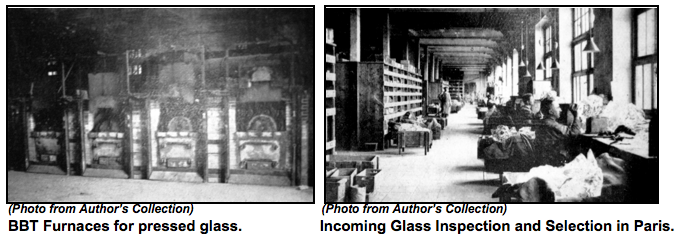
BBT chose to specialize each of its factories on one group of products. This allowed each factory to dedicate the training and increase the skills of workers and allowed for the specialization of machinery at each location.
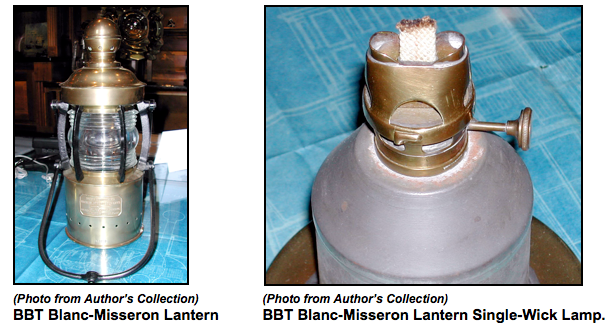
In 1918 the Société Anonyme des Anciens Etablissements Barbier, Bénard et Turenne was formed. This was the legal equivalent to the formation of an American corporation.
In 1921, a third factory was added at Aubervilliers, known as “La Commanderie,” which employed over 300 workers who constructed motors for the rotation of the lenses and for rotation of the parabolic mirrors used in beacons and spotlights. This factory also produced sound detectors for the French Army used to locate airplanes. It also produced Oxygen gas for many uses.
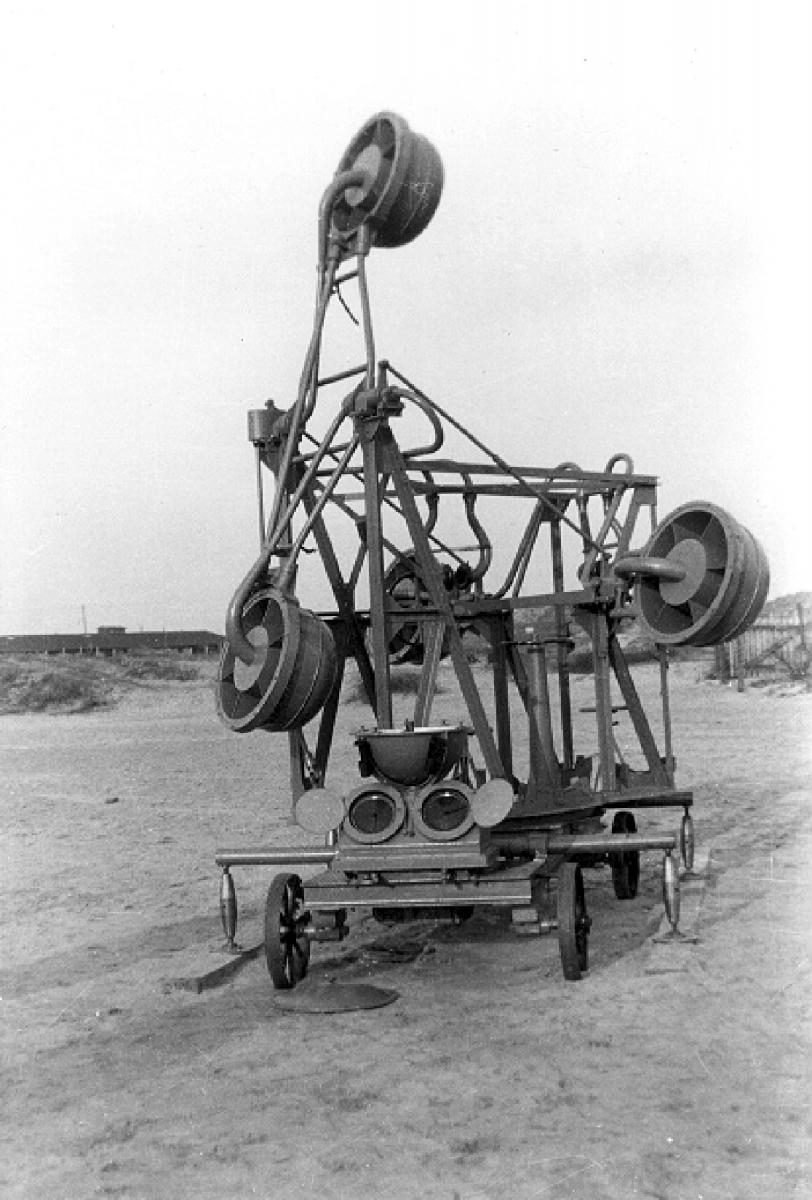
BBT Aircraft Sound Detector.
In 1928, BBT bought SIEGH, the “International Oil-gas Lighting Company.” The combined company produced dissolved acetylene at the Blanc-Misseron factory and other gases that BBT sold for maritime lighting.
By about 1930, more than two hundred special glass grinding machines were employed in the Paris factory to cut and polish the lens prisms and dioptric elements for lighthouses. Forty other machines constructed by BBT were used for the shaping of Mangin Mirrors having a diameter up to 2.5 meters that were used in searchlights and aero beacons as well as in lighthouse illumination.
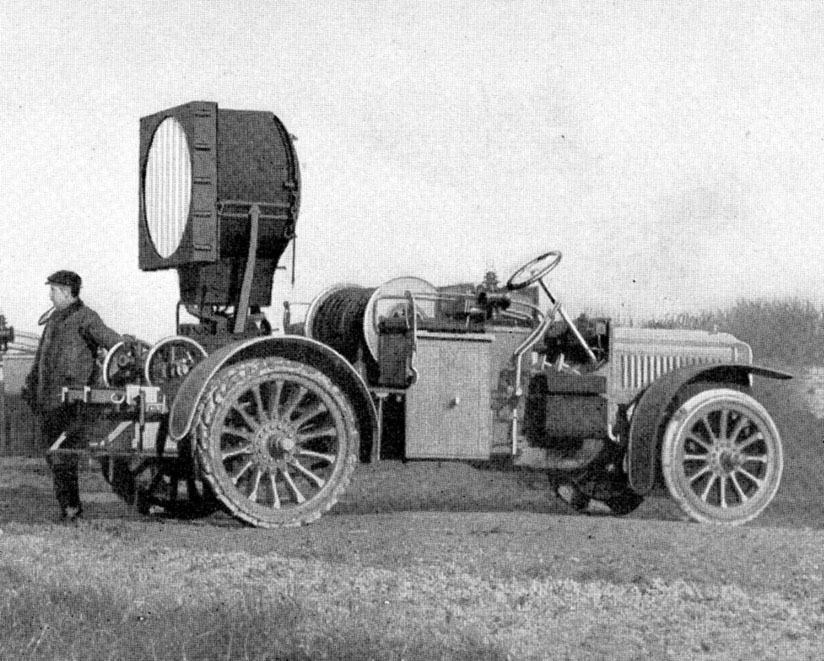
BBT Military Searchlight Mounted on a Truck.
In 1934, BBT bought the Krauss Company from the Leica Company in Germany. Krauss had been founded in 1882 and was a well-known maker of binoculars and microscopes. BBT formed a subsidiary company with the name BBT-Krauss, which continued to produce the former Krauss products along with a number of specialized military and aviation optical products.
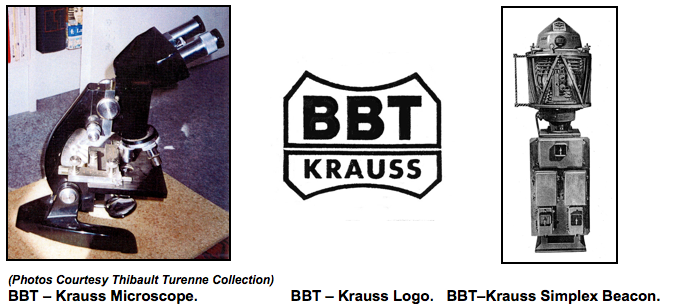
In 1935, another factory was created at Nazelles, France. It was a specialized factory that took over all operations from the Paris factory for the grinding of glass for mirrors used in searchlights, for the optics of lighthouses, and for lighting devices used in hospital operating rooms. It also performed the machining of large precision metal products such as mercury bath castings and other elements of Fresnel lens pedestals. This plant also manufactured pressed glass lenses for buoys and other lighting devices. At this time the Paris factory was reduced to just the final assembly of Fresnel lenses, laboratories for research in electronics and sound, and the main office and sales function of the company.
By the 1960s the company was producing electronic equipment such as RADAR and infrared sensors for the military, mining and mineral handling equipment, and optical instruments for use in medicine.
(Photo Courtesy Thibault Turenne Collection) BBT Operating-Room Lights.
BBT was the last French manufacturer of Fresnel lenses. However, by about 1965, the last large Fresnel lens had been produced at BBT. BBT continued to produce small buoy lenses and began to produce acrylic lenses at this time.
In 1968, BBT was formally split into two companies: BBT - Paris, which operated the factories in Paris, Nazelles and Aubervilliers and BBT - Valencienne, which operated only the Blanc-Misseron factory. BBT also owned a number of subsidiary companies or licensed its products to other companies across the world such as:
- BBT Corporation in America - formed in 1928
- Scialytic Corporation in America - formed in 1928
- Industrielle Boraine (IB) in Belgium - formed in 1928
- Technical Lights and Equipment (TLE) in England - formed in 1930
- Segnalamento Maritimo ed Aero (SMA) in Italy - formed in 1945
- Beaconing Optical Precision Materials (BOP) in Canada - formed in 1948
- Micronal in Brazil - formed in 1954
- Alumbrado BBT in Spain - formed in 1964
On December 26, 1976 the glass grinding and polishing plant at Nazelles burnt down and the BBT production capability in this area was dramatically reduced.
In 1981, CIT ALCATEL, a French conglomerate, bought BBT and began to split up the various parts of the company. It decided not to continue the navigation aids business and in 1984 it began to look for a buyer for this segment. A year later, the French Minister of Marine requested that part of the French Government’s export activities in the area of navigation aids be privatized. This was accomplished by forming a new company named GISMAN, which absorbed the French Government operations and the navigation aids business of CIT ALCATEL (formerly BBT).
The new company’s head offices remained at 82 Rue Curial in Paris and in 1990 the company became Samtec-GISMAN, which still produces navigation buoys. In 2001, Samtec-GISMAN, moved its offices west into Brittany and the operations in Paris moved to 85 Avenue de Neuilly, which became a sales office only.
Other Fresnel Lens Makers
This is the final segment of the story of the Fresnel lens makers. In this article the AGA, Pharos Marine, Automatic Power, Corning, Macbeth-Evans, Gebr. Picht, Dr. Genthe Glass, Nitsche & Gunther, Julius Pintsch, and Wilhelm Weule glass and lens makers will be described.
There are a number of other makers of navigation aids that have not been included in this series of articles because they did not produce glass Fresnel lenses. A partial listing of these companies is as follows:
- Amerace in America
- Carmanah in Canada
- Impulsphysik in Germany
- Pelangi in Great Britain
- Tideland Signal in America
- Vega Industries in New Zealand
- Veitmeyer in Germany
AGA Lens Works
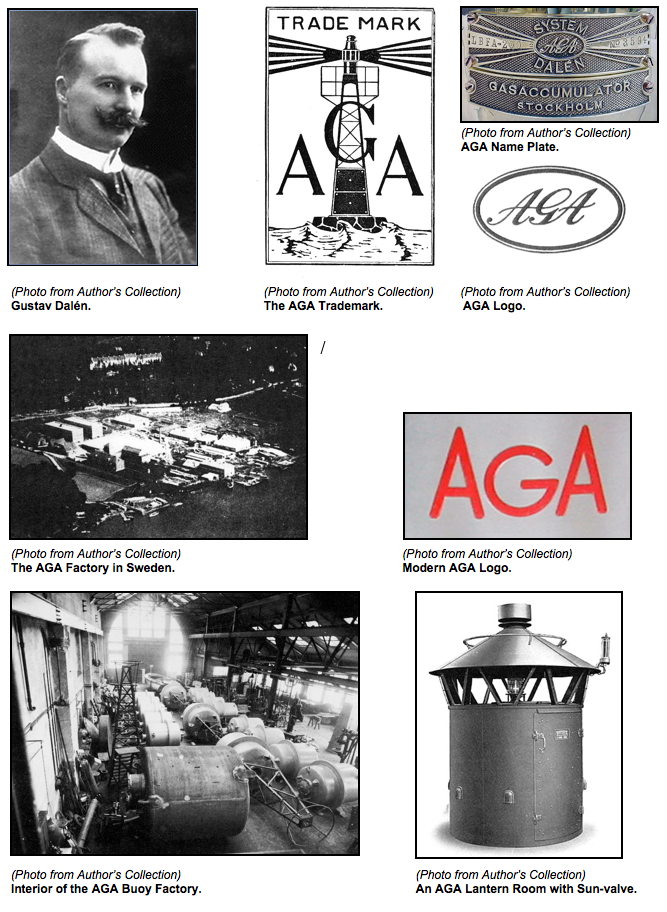
The acetylene process was invented by a Canadian, Thomas Leopold Willson, in 1892. Willson also invented the idea of generating acetylene inside a buoy in 1904. When acetylene was employed in lighthouse work, the gas was either supplied in cylinders, or was generated on the spot.
In 1896, two Frenchmen, George Claude and Albert Hess developed a method to store compressed acetylene by dissolving it in acetone held in steel cylinders (dissous-acetylene). In this system the gas was compressed into cylinders filled with a porous substance, and with acetone, a liquid having the remarkable power of absorbing at atmospheric pressure twenty-four times its own volume of acetylene gas. Its power to absorb the gas increases in proportion to the pressure, so that at a pressure of ten atmospheres it will dissolve two hundred and forty times its own volume of acetylene gas.
AGA
The Svenska Carbid och Acetylen Company was started in Gothenburg, Sweden in 1899 to develop acetylene gas as a lighting product. In 1901, the Carbid Company bought the Scandinavian patent rights for dissous-acetylene and moved to Stockholm. At that time, Nils Gustav Dalén worked as Chief Engineer at a small consulting company named Dalén & Celsing, which represented the Carbid Company in the Stockholm area. The Carbid Company was taken over by the AB Gasaccumulator Company (AGA) in 1904. Dalén was contracted for as a Consultant Engineer, and by 1906 Dalén was employed fulltime as the Chief Engineer at AGA. Acetylene was also known as Dalén gas.
The First AGA Factory.
Dalén invented a number of types of equipment using acetylene as the light source of lighthouses and buoys, including:
- The flasher (1905). The flasher controls the duration of the light and dark periods, corresponding respectively to the times that the flame is burning and turned off. The regulated gas enters the flasher on the right side. The gas is collected and, at a set point, a burst of gas exits the flasher on the left and is piped to the burner, where it is ignited by the pilot light, causing a bright flash of burning gas. The flasher then resets, during the adjustable dark period, while it collects another quantity of gas for the next burst of flame.
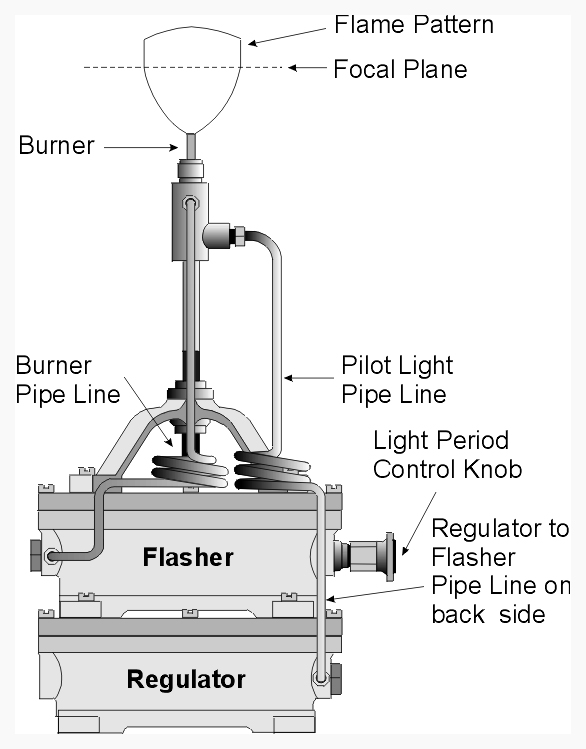
The AGA Flasher and Regulator-Mixer.
- AGA compound used within the acetylene storage cylinders (1906). The AGA compound was produced by filling each acetylene gas storage cylinder with a mixture of asbestos and diatomaceous earth. The compound provided a porous storage medium that greatly reduced the potential for an explosion should the storage cylinder be bumped or dropped.
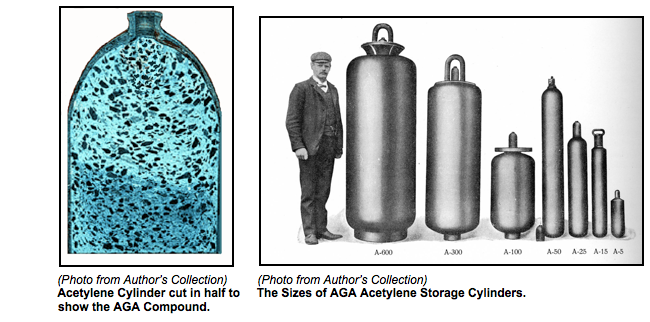
- The regulator-mixer (1907). The regulator-mixer provided a means to supply acetylene at a constant pressure with the appropriate mixture of oxygen to the flasher or incandescent mantle. (See drawing with flasher above).
The regulator forms the base unit within the regulator – flasher – burner combination. High-pressure acetylene enters the regulator from the acetylene tank and the regulator produces acetylene regulated to a pressure of 20 psi through a series of valves and a diaphragm. There are two exit pipes, one, shown in the drawing, that goes from the regulator to the side of the burner, which supplies gas to the pilot light, and a second pipe, not shown in the drawing that is behind the regulator – flasher assembly, which supplies gas from the regulator to the flasher.
- The Sun-valve (1907). The Sun-valve extinguished the light in the morning and re-lit the light in the evening. The Sun-valve was made from a heat-absorbent black rod in the center of three highly reflective gold-plated copper bars. When the black rod was warmed by the sun it absorbed the heat and expanded downward, closing a small valve in the main gas line. When it was nearly dark, the black rod cooled and contracted, moving upward, thus opening the valve and allowing the acetylene gas to be ignited by the pilotlight.
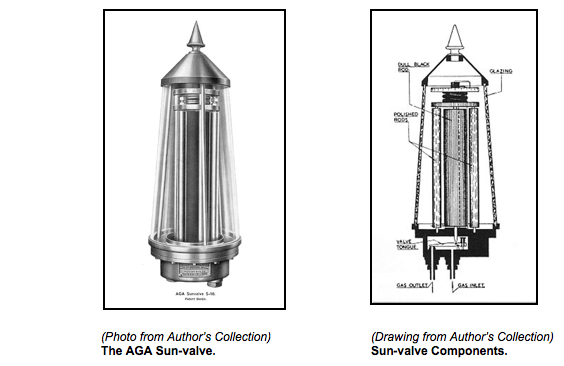
- The AGA lightship lens pendulum (1915). Lightships continued to use reflectors long after they were superseded in lighthouse towers because when a lightship rolls with the sea a fixed lens would roll as well so the focal plane of the lens would send the light in many directions as the ship moved. Reflectors could be easily mounted in gimbals, which solved the problem for all but the worst storms. When Fresnel lenses came into use there was no easy way to provide a gimbal; reflectors continued to be used. Dalén designed one of the first practical gimbals to support a Fresnel lens on a lightship. Three styles were made: a solid shaft and a weight, a weight hung from heavy wire cables, and a solid shaft with dual gimbals and support cables.
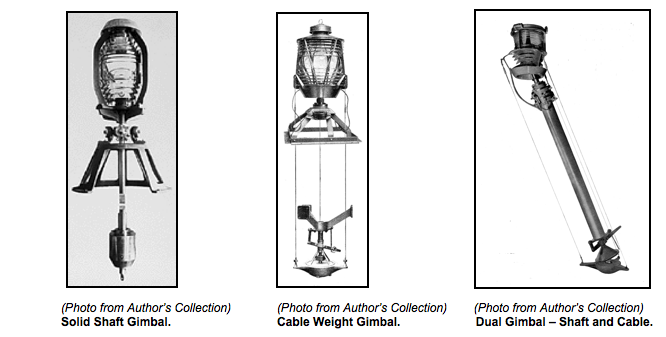
- The automatic mantle changer (1917). The automatic mantle changer has four mantle holders, which are initially loaded with mantles and wooden fuses by the keeper. The automatic mantle changer’s clockwork drive is then wound up and the first mantle holder is raised into position with its mantle placed directly below the burner. When the mantle burns out, the burner flame will protrude downward and ignite the chemically impregnated wooden fuse, causing it to disintegrate and lower the upper portion of the mantle holder. With the lowering of the upper portion of the mantle holder, the clockwork motor is allowed to continue turning the rotating cam wheel, which removes the current mantle holder and broken mantle from the burner and replaces it with a new mantle holder and mantle. This operation continues until all four-mantle holders and mantles have been used.
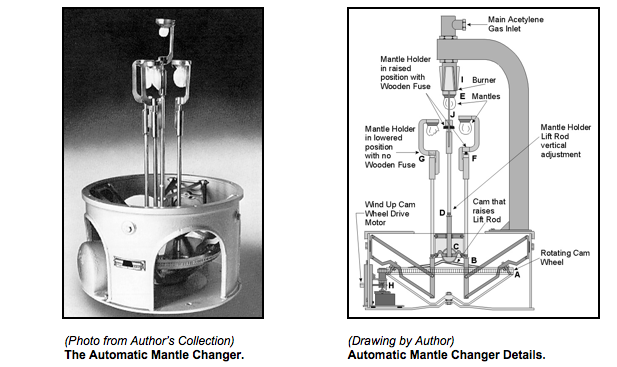
Gustav Dalén became president of the newly formed Svenska AB Gasaccumulator Company, still known as AGA in 1909. At this time there was a great increase in both railroad and automobile traffic and AGA became involved in the production of both railroad and traffic signals.
In 1912 the entire operations of AGA were moved to a newly built factory in Lidingo, Sweden on the Baltic Sea. In the same year, Dalén was blinded in an acetylene explosion while testing safety devices on acetylene cylinders. He recovered from all injuries other than his loss of sight and was able to continue his presidency of the company and inventive genius. In the following year he received the Nobel Prize in physics for the Sun-valve design.
The beginning of World War l caused great disruption with the supply finished sub-assemblies and raw materials. AGA was forced to begin making its own Fresnel lenses, parabolic mirrors, metal parts, and other products. AGA produced mainly pressed glass buoy lenses and small Fresnel lenses for beacons. AGA was awarded the contract for lighting the Panama Canal in 1912 and supplied most of the smaller Fresnel lenses, many purchased from Wilhelm Weule, in Germany, while Macbeth-Evans, in America supplied the Fresnel 4th order fixed and Fresnel range lenses used in the lighthouses along the canal.
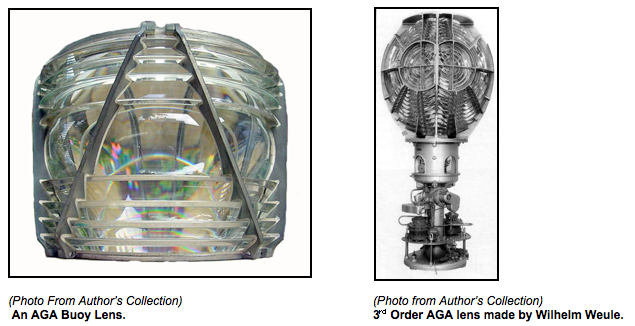
Gustav Dalén died on December 9, 1937. By 1940, AGA had entered the mobile radio business. During World War II AGA focused on defense equipment that included radios, aircraft instruments, military optics, and the production of wings for fighter planes. After the war, many of AGA’s gas production facilities were in Soviet territories and were taken over.
In 1947, AGA purchased a former German battery company and rapidly expanded into battery sales. In 1950, Gustav Dalén’s son, Gunnar Dalén, became head of the company.
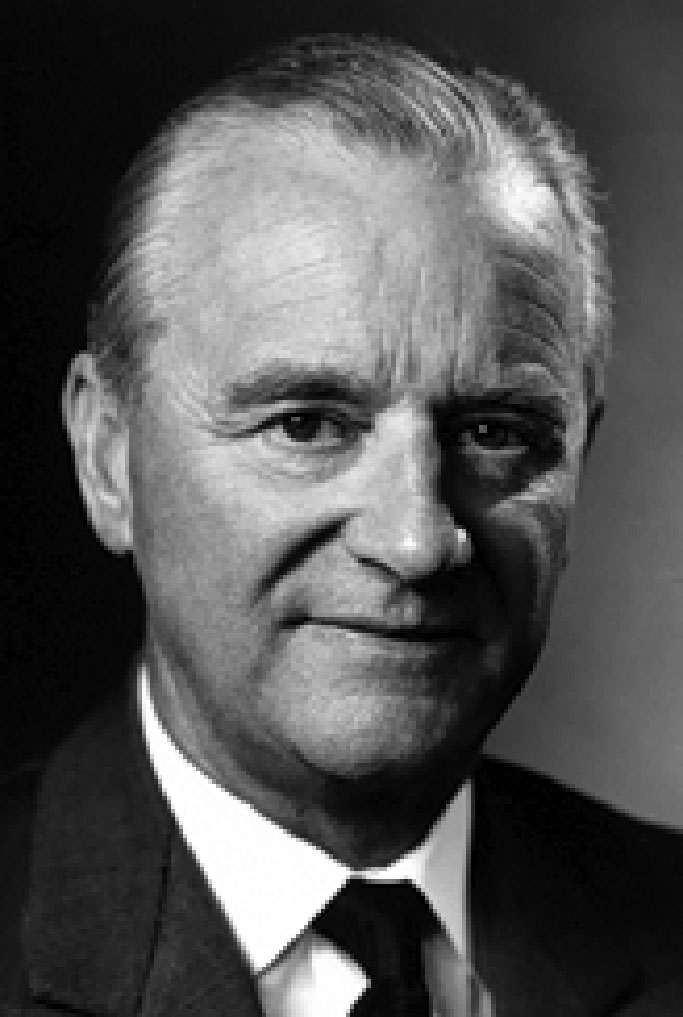
Gunnar Dalén.
In late 1984, the navigation aids division of AGA was sold to a new company AB Pharos Marine (see below) leaving AGA only in the gas production business. On July 1, 2000 the remaining gas production portion of the former AGA Company was purchased by the Linde Gas Company. AGA as a company no longer exists.
Pharos Marine
Stone Holdings bought the navigation aids portion of Chance Brothers in 1954, and continued in only that business until it was finally closed and sold between 1975 and 1977. Portions of its product line were acquired by AGA Navigation Aids Ltd, which in 1984 became AB Pharos Marine.
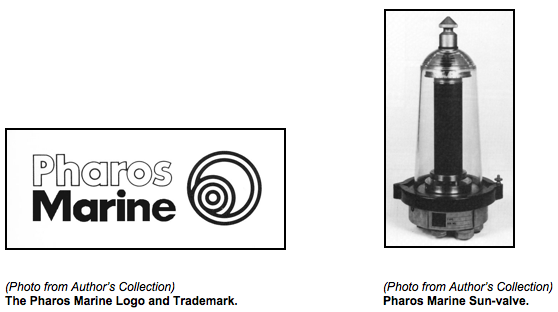
Automatic Power
Automatic Power Inc., with its head office in Houston, Texas, originated in 1947 under the name of The Lighthouse Inc.
The original company served the Gulf of Mexico coastline, and in 1948, provided the first oil-rigs in Texas with aids to navigation. As drilling exploration expanded, a foghorn capable of being heard two miles was required by the U.S. Coast Guard, which was developed and refined by The Lighthouse Inc., and subsequently patented in 1949.
The Lighthouse Inc. progressed rapidly, and by 1966, the company had expanded to five separate companies throughout the world. A merger with Wallace & Tiernan took place in the same year. Wallace & Tiernan was a supplier in the navigation aids business and was best known for their automatic bulb changers.
A Wallace & Tiernan Bulb Changer.
The five Lighthouse Inc. companies combined with the aids to navigation manufacturing and distribution activities of Wallace & Tiernan, to form the Automatic Power Inc., division of the Wallace & Tiernan Group. A subsequent merger of Wallace & Tiernan and Penn Salt Chemical formed the Pennwalt Corporation, making Automatic Power Inc., a division of this larger group. With the added financial strength of Pennwalt, Automatic Power Inc. became one of the leading marine aids to navigation manufacturers and contractors in the world.
In 1988, the French chemical conglomerate, ELF-ATOCHEM, bought the Pennwalt Corporation. Pennwalt decided to sell Automatic Power, Inc. to a management group. In 1989, Automatic Power was merged with AB Pharos Marine, Ltd., becoming the largest aids to navigation company in Europe.
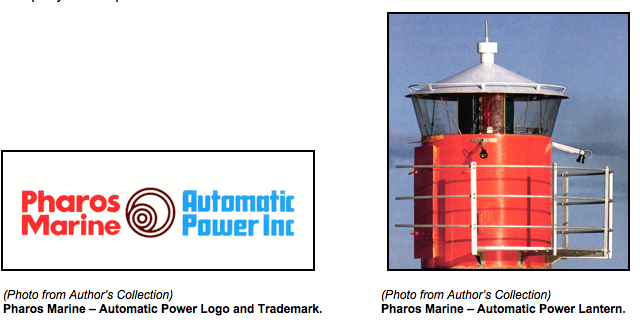
Corning Glass Works
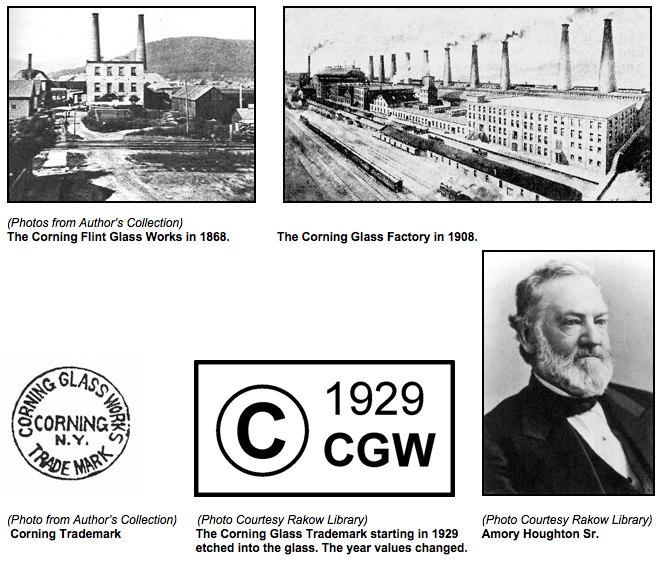
In 1852, John L. Gilliland of the Brooklyn Flint Glass Company patented a method of using pressed and molded flint glass for lenses. The Brooklyn Flint Glass Company made small Fresnel bull’s-eye lenses for use in railroad lamps, steamboat and dock lamps. They proposed the use of their lenses for lighthouses and in 1858 produced a very small number of pressed flint glass 6th order lenses. The quality of the pressed flint glass was not as good as the ground and polished glass used in Europe. In 1864, the Brooklyn Flint Glass Company went bankrupt.
(Photo Courtesy Rakow Library) A Brooklyn Flint Glass Lantern with Fresnel Lens.
Amory Houghton Sr. started in the glass industry in 1851 and in 1864 he, his son Amory Jr., and others purchased the Brooklyn Flint Glass Company. Houghton Sr. moved the company to Corning, New York and established the Corning Flint Glass Works on October 22, 1868. This company was incorporated as the Corning Glass Works in 1875.
In 1908 Corning developed an especially hard glass called Nonex. Nonex was a new type of borosilicate glass that could handle temperature extremes. A few years later in 1915, Corning introduced another variation of borosilicate glass known as Pyrex. Pyrex was especially useful as ovenware and became a highly commercial product.
Another version of Pyrex glass was used to create the 20-ton, 200-inch diameter mirror for the Hale Telescope on Palomar Mountain, California during the years 1934 through 1936. This was, and still is, the largest one-piece mirror ever cast.
Corning went on to develop many other products using its expertise in the properties of glass. Corning invented Corelle dishware in 1970, which became one of the leading sellers of low cost dishware. In addition, Corning developed silicone lubricants and sealers, fiberglass and, more recently, fiber-optic cables for use in telecommunications.
Corning continues in business today and is one of the largest and most innovative of the American glassmakers.
Corning Lens Works
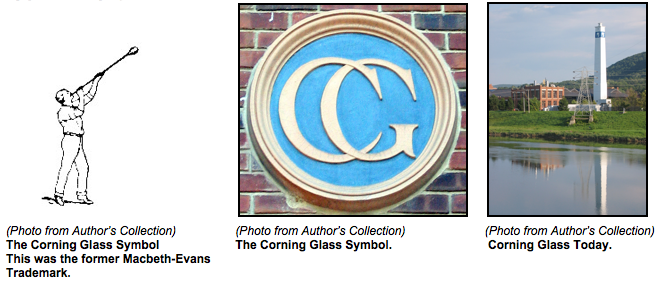
Note: In the photo of Corning glass today, the large 187 foot tall tower that looks like a smoke stack is, in fact, a special glass tube-drawing tower where glass was pulled into very fine long tubes, which were then cut into short lengths for making thermometers and other items.
The first patent recorded in the name of Corning Glass Works was granted to Charles F. Houghton, Amory Jr.’s brother, in 1877 for an improved Fresnel-type railroad semaphore lens.
(Drawing Courtesy US Patent Office) C. F. Houghton’s Patent Drawing.
Houghton’s design resolved a major problem with dirt contamination on lenses used in railroad work. The standard design of Fresnel lenses for railroad lanterns used external lens rings as shown on the left above. Fresnel lenses had always been made in this fashion. The external dioptric rings collected dirt and quickly reduced the efficiency of the lens. Houghton designed a lens with the dioptric rings inside the lens as shown on the right above. This design completely eliminated external dirt contamination. A few years later Chance Brothers in England began making 3rd order and smaller lenses for lighthouses using the same concept with smooth external surfaces of the dioptric belt.
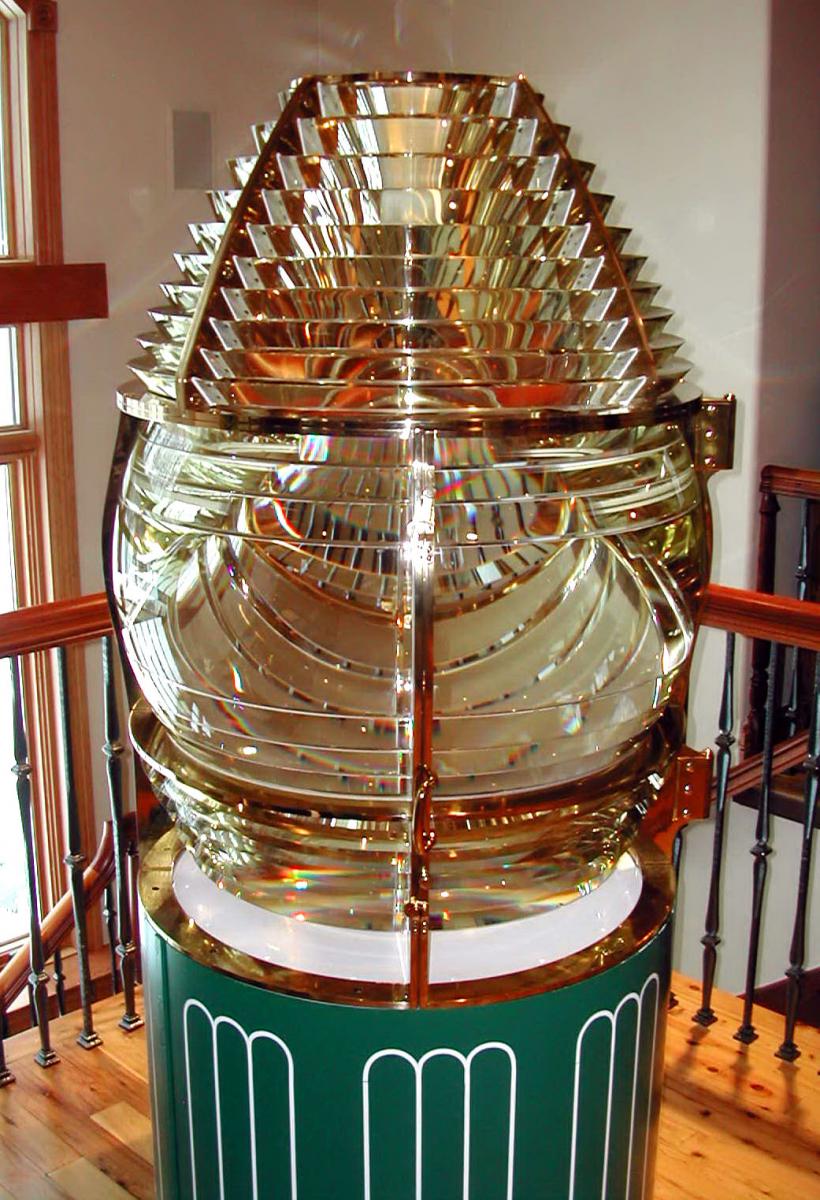
A Middle 3rd Order Lens with a Dioptric Belt with Smooth Exterior.
Corning made glass for signals and lanterns from its beginning although the glass used was not of true optical quality. The company worked hard to improve its glass, the optical design of its lenses, and its formulas for colored glass. By 1900, Corning had introduced a new type of ruby glass made with a cadmium selenide additive expressly for railroad signal use. Corning’s Nonex glass reduced breakage in railroad signal lenses due to heat cracking by more than 60%.
Corning also worked closely with the Railway Signal Association to develop a standardized selection of colors for railway signal lamps. Corning’s colors became the standard for all railway signals in America and most of the world.
Corning Glass made Fresnel lenses from pressed Nonex and Pyrex glass for the Lighthouse Service. In Lighthouse Service Bulletin No. 60, from December 1916 it was reported:
“Experiments have been carried on for some time at the general lighthouse depot, Tompkinsville, NY with a view to the manufacture of 375 mm. pressed-glass buoy lenses for use in place of the present expensive cut-glass lenses. The third inspector now reports that pressed-glass lenses, which from practical tests both with the naked eye and with the photometer have proven of equal efficiency to the cut-glass lenses, can be made for about $150 each, a saving of $250 over the cost of the cut-glass lenses. The pressed-glass lenses will be adopted for use in all 375 mm. lanterns purchased hereafter.“
Corning produced 200 mm., 300 mm., and 375 mm. pressed glass lenses for buoy and beacon lights.
At the end of 1936, Macbeth-Evans Glass Company merged with the Corning Glass Company (see the Macbeth-Evans Glass Company later in this document). The merger with Corning Class brought the ability to make true optical quality glass and cut-glass Fresnel drum-style lenses into the Corning Glass list of products. Corning never made the “classical” Fresnel lenses used in lighthouses. However, they did make lenses for buoys, beacons, and the glass elements of the DCB-36 aero beacon.
A DCB-36 Aero Beacon.
Macbeth-Evans Glass Works
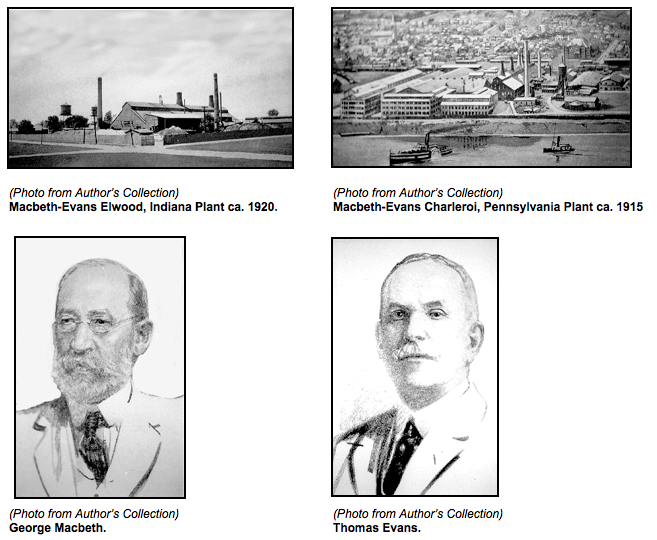
George Macbeth began his career in glass making in Pittsburgh, Pennsylvania in 1872 with the manufacture of glass chimneys for oil lamps and became one of the world’s largest producers of lamp chimneys by 1880.
In 1890, George Macbeth built the Macbeth Glass factory in Elwood, Indiana. Elwood was chosen because a very large source of natural gas had just been found in the Elwood area, which could fuel the glass melting furnaces. The Elwood plant was specifically designed to produce large quantities of lamp chimneys, but Macbeth had always had a fascination with optical glass. He devoted a special room and one-pot furnace to its production and in 1891 began making very small experimental batches of optical glass.
Macbeth won a prize at the Columbian Exposition in 1893 for producing the first high quality optical glass in America. In 1899, Macbeth Glass merged with the Thomas Evans Glass Company to form Macbeth-Evans, which then became the world’s largest producer of lamp chimneys, and major manufacturers of a variety of other glass articles.
At the end of 1936, Macbeth-Evans Glass Company merged with the Corning Glass Company and in 1938 the Elwood plant was closed and sold.
Macbeth-Evans Lens Works
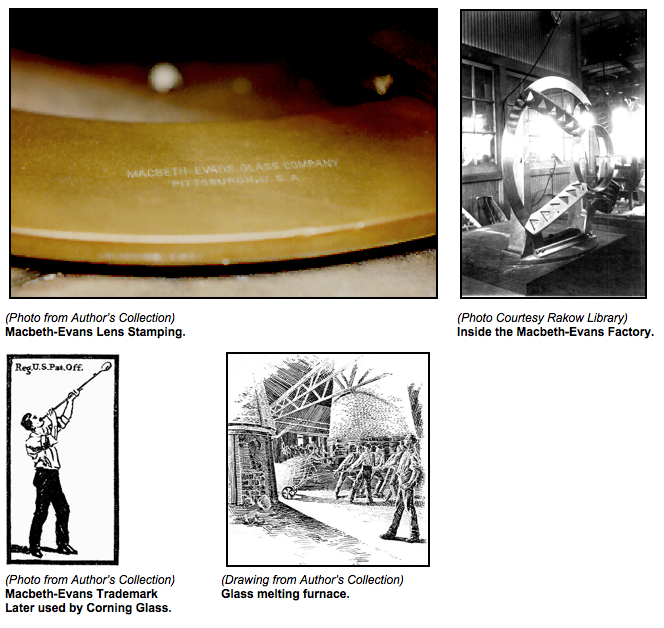
In 1910, the Lighthouse Bureau approached Macbeth-Evans and requested that they evaluate the possibility of producing a small fifth-order Fresnel lens for use on American lightships. Macbeth-Evans accepted the Fresnel lens project and started an evaluation of all parts of the design and construction of such lenses, as well as the composition and manufacture of the lens glass.
The glass used in all of Macbeth-Evans lenses was different from that used by the European makers. Macbeth-Evans used flint glass with an index of refraction of 1.55 versus the European crown glass standard of 1.52, and a density of 2.95 versus 2.52 for Europe. The glass was known as non-hygroscopic, meaning that it does not absorb any moisture. It was a heavy, brilliant flint glass with a very slight gray color, and it would take a finer polish than European crown glass. This type of glass was harder to make, especially without bubbles and striae.
Macbeth-Evans lenses were also improved over European lenses in their physical design. George Macbeth hired Professor Harry S. Hower, of the Carnegie Institute of Technology, to design the prisms used in his lenses. Professor Hower noted that in European prisms only one of the sides of the prisms was slightly curved, which improved its ability to direct the light as needed. The Macbeth-Evans prism design was constructed with two conical surfaces and the third surface was a hyperboloid of revolution giving still more enhanced light throughput and control. This structure was more complicated than any other manufacturer had successfully produced, and Macbeth-Evans lenses were found to transmit as much as 50 percent more light than the European lenses of the same type and size.
The Macbeth-Evans prisms were manufactured completely by machine. The grinding and polishing equipment was developed by Mr. Heupel, the Macbeth-Evans manufacturing engineer, and allowed highly accurate and lower cost manufacture. Mr. Heupel also developed designs for all of the brass-work that was used to frame the finished lens panels. This brass-work was held to very high tolerances, which reduced the cost for the initial setup and testing of the lenses.
By the time Macbeth-Evans developed the capability to produce Fresnel lenses, the major lighthouse construction era had ended and there were few orders. Macbeth-Evans built very small quantities of Fresnel lighthouse lenses and a considerably larger number of buoy lenses, during the period from 1910 to 1932. Macbeth-Evans also built most, possibly all, of the fourth-order range lenses used along the Panama Canal. They were very proud of their being the only U.S. manufacturer with these capabilities.
The German Makers
Gebr. Picht & Co. Glass and Lens Works
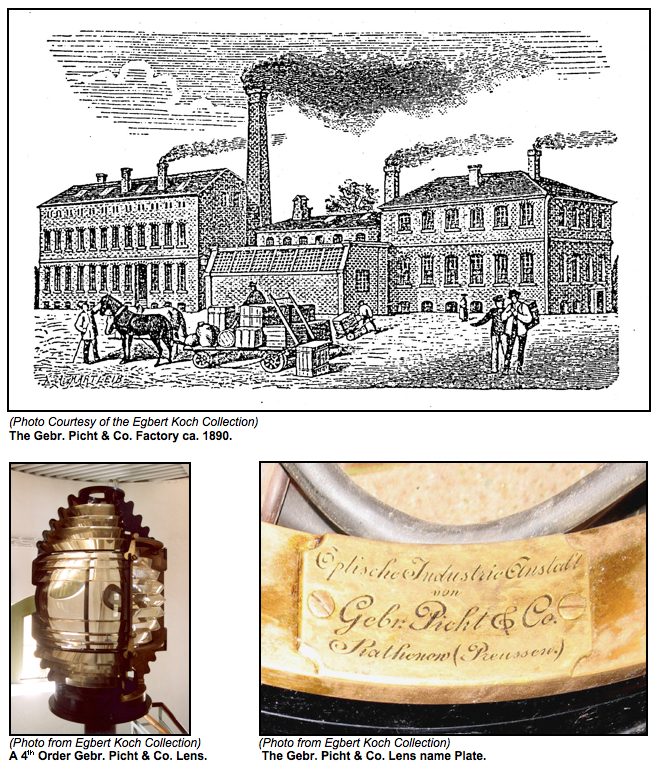
The French supremacy in the manufacture of optical glass and Fresnel lenses in the 1830 to 1870 period caused national reactions in the glass industries of other countries, notably in Germany. The German authorities decided to promote their own optical glass industry. Gebr. Picht & Co. started at Rathenow, Germany in 1859 as a maker of eyeglasses. Gebr. Picht & Co. added the production of precision prisms for Fresnel lenses to its product line in 1878. The raw materials for its products were purchased from others. However, in 1884 Emil Busch and other companies began producing Germany’s first optical glass in the towns of Jena and Rathenow.
After 1893, in co-operation with Julius Pintsch, (see detailed description later in this document), Gebr. Picht & Co. delivered its first complete Fresnel lenses. It produced a small number of Fresnel lenses mainly for the German Lighthouse Service and only a few for other lighthouse services. It also produced ship lanterns for the German Navy.
Another company, the Altstädtische Optische Industrienanstalt, originally formed in 1866, was supervised by Nitsche & Günther at Rathenow (see a detailed description later in this document). The Altstädtische Optische Industrienanstalt merged with Gebr. Picht & Co. in 1875. Gebr. Picht & Co. continued under its own name until 1900 when the entire Altstädtische Optische Industrienanstalt changed its name to the Nitsche & Günther Company.
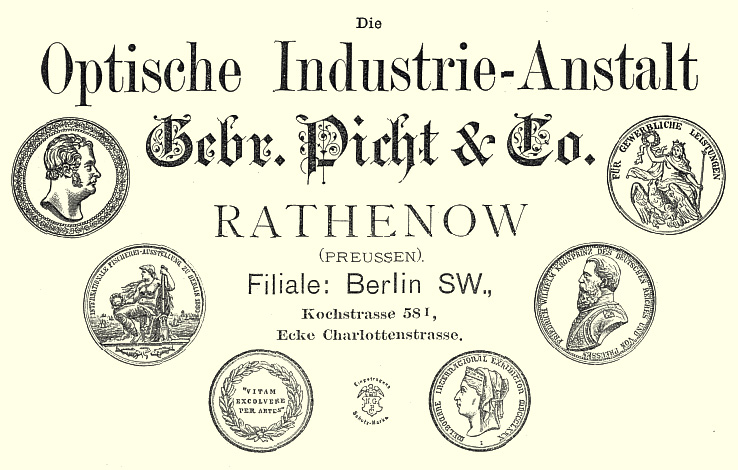
(Photo from Egbert Koch Collection) The Medals won by Gebr. Picht & Co.
Nitsche & Günther Glass Works
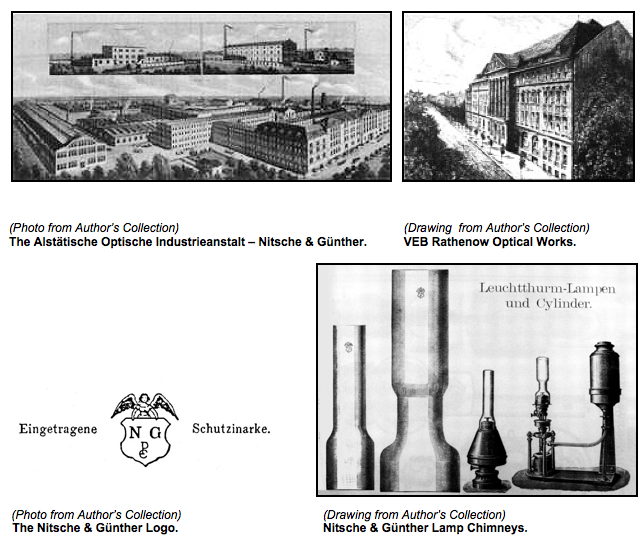
Nitsche & Günther was originally formed as a manufacturer of eyeglasses and spectacle frames. The Alstätische Optische Industrieanstalt, Nitsche & Günther was established by Ernst Nitsche and his partner August Günther at Rathenow, Germany on April 15, 1866.
Alstätische Optische Industrieanstalt continued to progress under the direction of Nitsche and Günther and in 1875 the Gebr. Picht Company was merged into the enterprise. In 1898 the C.W. Muth Company was also absorbed into this industrial group. The addition of these two companies allowed Alstätische Optische Industrieanstalt to make small Fresnel lenses and specialize in the manufacture of large lighthouse lamp chimneys. Nitsche & Günther itself became one of the biggest European manufacturers of eyeglasses and spectacle frames.
By 1896, Rathenow had 163 optical enterprises and in 1900 Rathenow was a center of the optical industry in Germany, and came to have the honor of being named The City of Optics. In that same year the entire Altstädtische Optische Industrienanstalt changed its name to the Nitsche & Günther Company.
The production of Fresnel lenses and ship lanterns was probably discontinued shortly before WW I or during the first years of the war because the manufacturing of eyeglasses and spectacle frames was more lucrative.
During the Second World War the Nitsche & Günther factory was heavily damaged. In October 1945, work began to rebuild the factory buildings. However, since Nitsche & Günther had taken part in the production of military equipment, it was expropriated by the Soviets. On March 8, 1946, Emil Busch AG and Nitsche & Günther Optische Werke formed the Rathenow Optical Works in the then Soviet-occupied “East German” area, which in 1948 became VEB Rathenow Optical Works.
Wilhelm Weule Lens Works (Pronounced Voy-Lie)
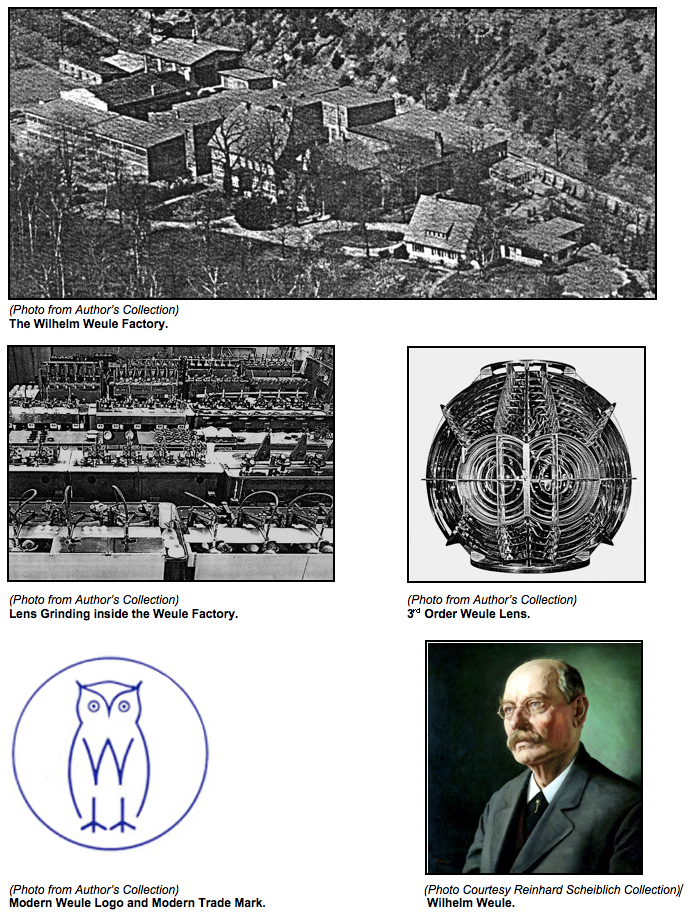
Wilhelm Weule Lens Works
Wilhelm Weule and his brother were well known makers of tower clockworks for town halls and churches, and also produced rotation clockworks for lighthouses. At that time, all of the German navigation aids and equipment, both optical and mechanical, were purchased from foreign countries. Wilhelm Weule was approached by the German authorities in 1895, which encouraged the creation at Goslar, Germany of an enterprise placed under his direction for the manufacture of lighthouse optics and other navigation aids. Late in 1895, Wilhelm began construction of the first factory building of the Weule Lens Works, which specialized in grinding and polishing glass prisms and other lens elements for Fresnel lenses. The first building was opened on April 1, 1896 and immediately began production. Weule purchased all of the glass it used from other suppliers and confined its work to the finishing of the glass elements and the assembly of them into the lens frames. By late in 1896, Weule had produced its first small ship lanterns.
(Photo Courtesy Egbert Koch Collection) Walter Körte.
Mr. Walter Körte was the chief designer of the German Navigation Aids System. He assisted the young firm and from that relationship a close scientific and practical collaboration emerged. Mr. Körte had to create the design calculations for each of the Fresnel lens elements on his own because the French and English designs were considered trade secrets. Körte’s work led to the creation of the German standard profiles for lighthouse optics that were eventually used by all the German lens manufacturers. Mr. Körte chose to add several additional sizes of lens orders that are used mostly in Europe such as the large 5th order (200 mm.), large 4th order (300 mm.) and middle 3rd order (400 mm.) lenses.
Due to the quick development of the German costal navigation aids system and also due to a number of large German Navy orders for lenses, there was a need to expand the production capabilities at Weule. In the year 1901, Wilhelm Weule was able to acquire a piece of land near the city of Goslar that included a number of factory buildings. An important reason for the selection of this site for the expanded factory was the availability of waterpower that could operate turbine and standard water wheels, which drove the glass grinding and polishing machines.
Weule also used its clockwork experience to develop clockwork controls for Otter blenden, which are a type of Venetian blinds used in lighthouses to produce flashing characteristics from fixed lenses.
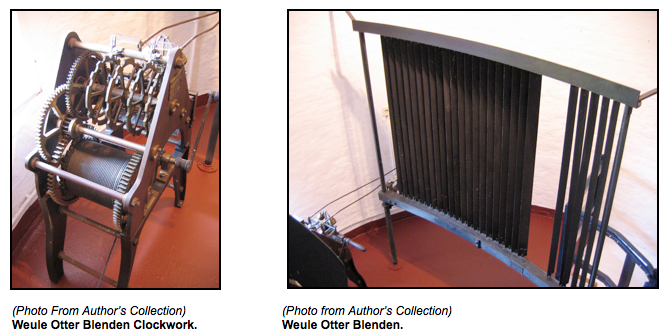
It was not long before the first orders from foreign countries arrived. One large order was from AGA for the lighting of the Panama Canal. Wilhelm Weule Co. built a large part of the smaller lenses needed by AGA, which had the overall contract for the Panama Canal. By 1910, a new machine house and a new grinding room were dedicated for the manufacture of the largest glass rings needed for Fresnel lenses. The dimensions of the optics produced by Weule constantly grew and a 1st order lens was first produced in 1913.
(Photo Courtesy Egbert Koch Collection) Front Page of the 1908 Wilhelm Weule Catalog.
During the First World War all of the company’s business was devoted to Fresnel lanterns to equip German warships. After the war there were a number of difficult years where production was very constrained.
Wilhelm Weule’s son, Gerhard Weule Sr., became a partner in the firm in 1921, and after the death of Wilhelm Weule in December 1925; he took over management of the firm. In 1926, together with his brother-in-law, Dr. Alfred Genthe, Gerhard established the Dr. Genthe Glass Works in order to guarantee the availability of near optical quality glass for the firm. Glass was procured from Dr. Genthe Glass Works, in Goslar or from Deutsche Spiegelglas A.G. in Grünenplan.
Weule soon began development of optics for many new areas. The early development of the aviation industry created a requirement for new optics for runway lights, tracking beacons, a parabolic mirror for cloud measuring instruments, and warning lights.
The first connection to railroad signal technology began around 1933. In collaboration with the train and the lantern manufacturers, the firm Wilhelm Weule set up production of highly effective deep mirrors. Later, after World War II, Wilhelm Weule constructed special aspherical lenses and established a highly effective production line. The track signals were equipped with these signal optics instead of the simple lanterns previously used. Somewhat later, the first newly designed catadioptric ring optics were delivered for signals positioned above the tracks.
Beginning shortly after WWII, large wide-screen movie theaters became popular. This was the beginning of production of a specialized movie theater mirror (for installation in movie theater projectors) by the Weule Company. These so-called "owl mirrors" soon became used by movie theater owners around the world. The owl mirror became so important to the firm that an owl symbol became its trademark.
Gerhard Weule Sr. died in 1955. His son Gerhard Weule Jr. was already active in the firm and became president. He expanded and changed the factory complex. The mechanical workshop was greatly enlarged in 1964. In 1965, Weule began the production of glass parabolic reflectors for military night vision devices. In 1971, a new machine shop was added housing modern glass cutting machines using diamond tools.
Weule’s close contact with the lamp manufacturers resulted in the design of a special elliptical glass reflector for xenon-lamps used in the horizontal position. The first such horizontal mirror was brought onto the market in 1972.
Gerhard Weule Jr. died in 1987 and the company was taken over by Johann Friedrich, Karin and Roland Weule and was made a public corporation.
Weule began developing equipment for the computer industry and expanded into specialized products used in space exploration such as ground glass ceramics for astronomical research and items for the space-lab mission.
In 1994, Weule developed specialized hexagonal mirrors that were used in experiments on a solar furnace. This design used 147 such mirrors, each 320 mm. across.
More recently Wilhelm Weule was involved with the movie industry’s conversion to digital techniques. Weule delivered the first special mirrors prepared for use in the precision digital projectors.
Weule filed for bankruptcy in May 2014 and shut its doors as of October 1, 2014.
Dr. Genthe Glass Works
Dr. Genthe Glass was founded in 1926 to assist the Wilhelm Weule Company. Dr. Alfred Genthe was the brother-in-law of Gerhard Weule Sr., Wilhelm’s son, and the new company was then known as the Dr. Genthe Optische Glashüttenwerk. Dr. Genthe supplied near optical glass to the Weule factory and others for the construction of Fresnel lenses, parabolic reflectors, and railway signals. Dr. Genthe Glass occupied factory buildings adjoining those of the Weule Company in Gloslar, Germany. Wilhelm Weule Company assisted Dr. Genthe Glass in getting established and supplied the property on which its factory was built. This was done to assure Weule a steady and reliable supply of glass and a glass research facility.
Dr. Genthe’s Glass factory was only slightly damaged during World War II and quickly resumed production. It filed for bankruptcy in 2008.
Julius Pintsch Lens Works
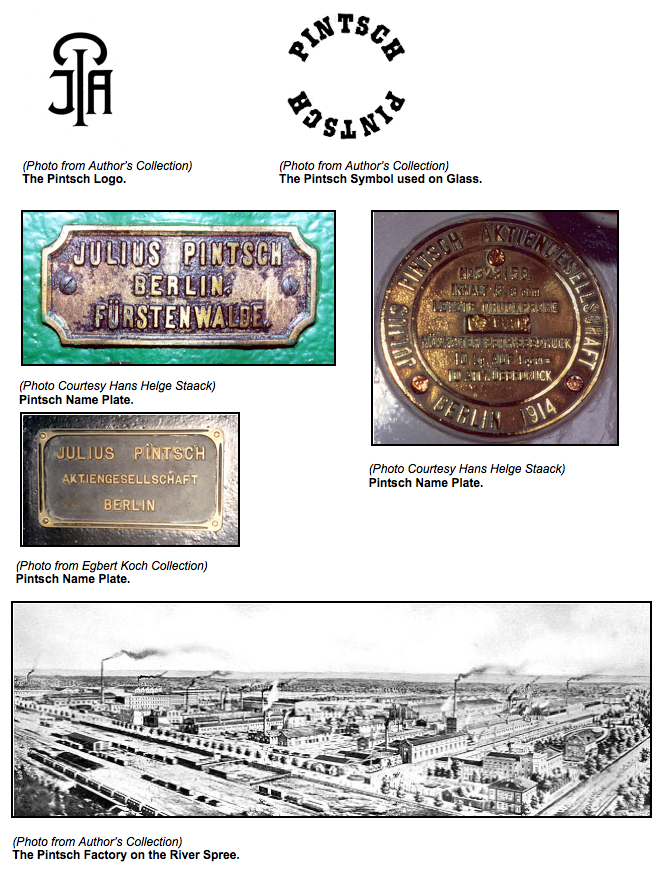
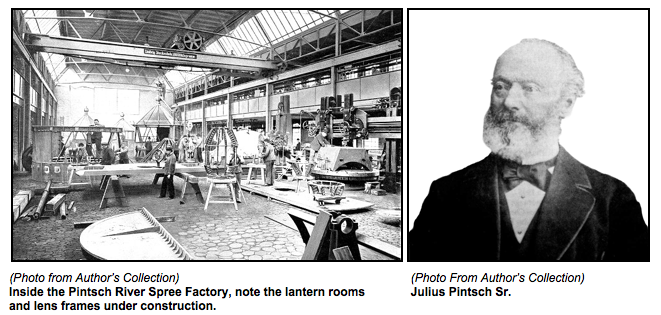
The firm of Pintsch AG was started by Julius Pintsch Sr. and carried on by his sons, Richard and Julius Jr. (known as Jules). Pintsch had several factories in Germany and elsewhere with the main factories in or near Berlin. The major factory producing navigation aids was located in a village near Berlin named Fürstenwalde on the River Spree. Pintsch produced compressed gas lamps and buoys, as well as small and large metal beacon towers, lighthouse lantern rooms, arc lamps, reflectors, fog signals, and I.O.V. and acetylene lamps. Pintsch sold lenses of many kinds and assembled lenses in its workshops. However, Pintsch did not produce the lens glass or make the prisms and lens elements, which were purchased from outside suppliers such as Wilhelm Weule and Gebr. Picht & Co.
Julius Pintsch Sr. invented a lamp and compressed gas system that was used in many forms for railroad lighting, street lighting and elsewhere. He named the fuel he used Pintsch gas or oil gas. It was what we would call natural gas (a mixture of methane and ethane).
Julius Pintsch Jr. was involved in the development of the use of Pintsch iron buoys during the late 1860s. At the opening of the Suez Canal in 1869, 105 Pintsch buoys were in place. In the early 1870s Julius Pintsch Jr. was traveling by train from St. Petersburg to Moscow in the company of a senior Russian official. The Russian happened to mention the serious need for lighted buoys along the coast of the Finnish Gulf between St. Petersburg and Kronstadt. Julius Pintsch Jr. went back to Berlin and immediately began the design of a compressed gas lighted buoy. By November 1876 the first lighted buoy had been produced and was tested in the Finnish Gulf. The Czar was so pleased with the buoy’s performance that Julius Pintsch Jr. was presented “The Order of Stanislaus”. By 1908, there were nearly 2400 Pintsch lighted buoys in operation throughout the world.
Richard Pintsch was involved in the development of the Incandescent Oil Vapor (I.O.V.) lamp. Richard and Carl Auer von Welsbach jointly designed a type of Bunsen burner that produced a very hot and non-shining flame. This burner, when coupled with a mantle, became the basis for the I.O.V. lamp. Richard Pintsch’s wife Marie knitted the first mantle from a combination of wool, cotton and silk.
Pintsch AG remained in production in Fürstenwalde until the end of the Second World War in 1945. Just before the war Pintsch had purchased an interest in the Bamag Meguin Corporation. By 1953, Pintsch owned the majority of the shares of Bamag and the company name became the Pintsch Bamag Corporation. The company remains in production today, located in Dinslaken, North Rhine Westfalia.

